A Summary of 1:1 Nurse Patient Ratio: Rapid Review of Reviews
VerifiedAdded on 2023/03/20

PROJECT FINAL OUTPUT
Name of the Student
Student Number
Subject Coordinator
Subject Name
Assessment number
Due Date
Word count
Title of the Review: A summary of the effectiveness of 1:1 nurse patient ratio: a rapid review
of systematic reviews
Paraphrase This Document
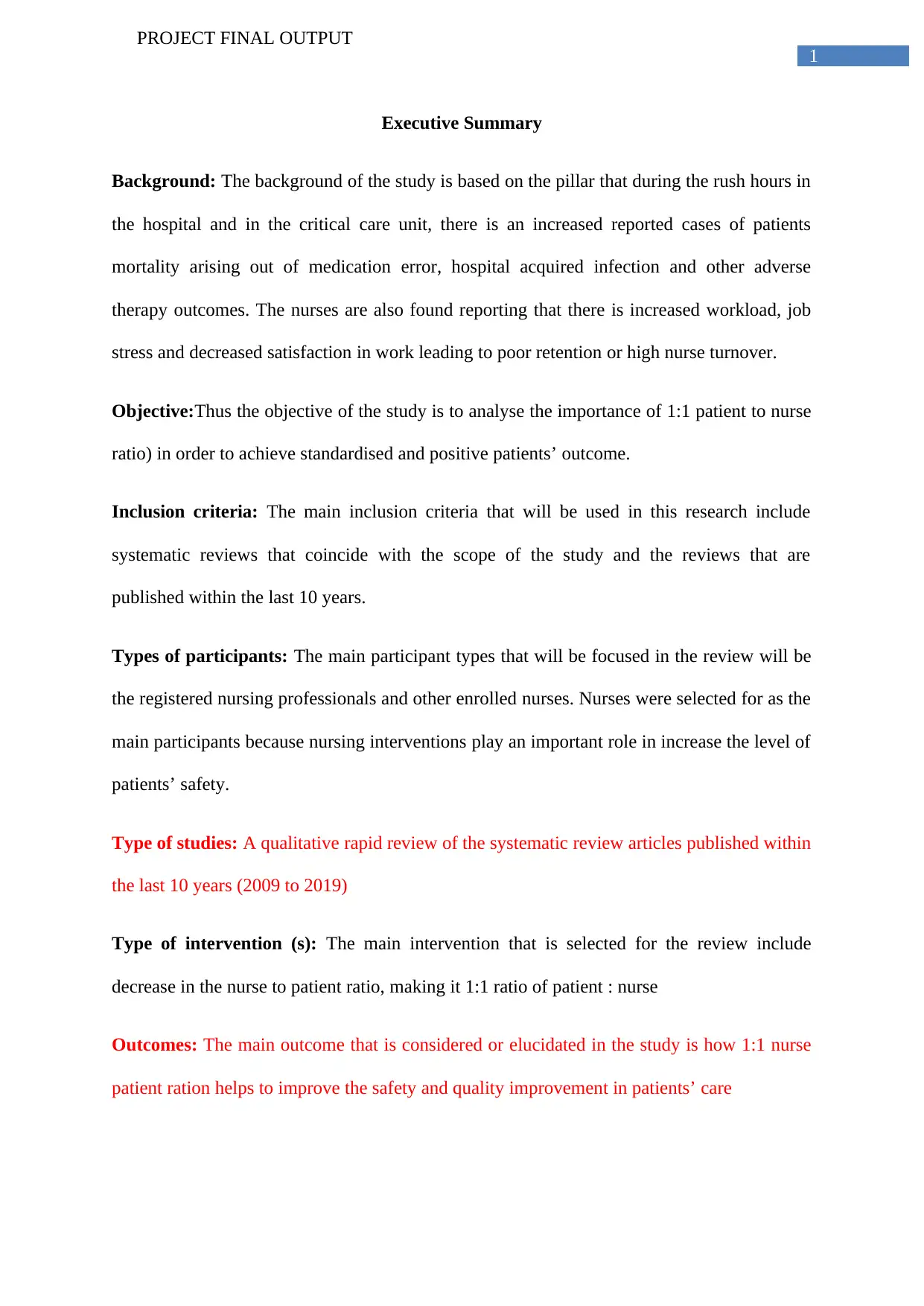
PROJECT FINAL OUTPUT
Executive Summary
Background: The background of the study is based on the pillar that during the rush hours in
the hospital and in the critical care unit, there is an increased reported cases of patients
mortality arising out of medication error, hospital acquired infection and other adverse
therapy outcomes. The nurses are also found reporting that there is increased workload, job
stress and decreased satisfaction in work leading to poor retention or high nurse turnover.
Objective:Thus the objective of the study is to analyse the importance of 1:1 patient to nurse
ratio) in order to achieve standardised and positive patients’ outcome.
Inclusion criteria: The main inclusion criteria that will be used in this research include
systematic reviews that coincide with the scope of the study and the reviews that are
published within the last 10 years.
Types of participants: The main participant types that will be focused in the review will be
the registered nursing professionals and other enrolled nurses. Nurses were selected for as the
main participants because nursing interventions play an important role in increase the level of
patients’ safety.
Type of studies: A qualitative rapid review of the systematic review articles published within
the last 10 years (2009 to 2019)
Type of intervention (s): The main intervention that is selected for the review include
decrease in the nurse to patient ratio, making it 1:1 ratio of patient : nurse
Outcomes: The main outcome that is considered or elucidated in the study is how 1:1 nurse
patient ration helps to improve the safety and quality improvement in patients’ care

PROJECT FINAL OUTPUT
Search strategy: The search strategy was conducted by the use of the keywords in two
electronic databases PubMed and CINHAL. Boolean operators were used in order to refine
the data. The initial search results were scanned for the removal of the duplicates and this was
followed by abstract analysis and then full-text analysis of 10 papers lead to the final
selection of 5 articles for the review
Methodological quality: The methodological quality of the articles that was selected for the
final review was done by the use of the AMSTAR critically analysis tool. The articles with
score 8 to 10 score were selected for the review.
Data extraction and data synthesis: Data extraction and data synthesis was done with the
help of narrative data analysis
Results: Results highlighted that increased level of nurse staffing helps to improve the level
of patients’ safety and at the same time helped to improve the overall level of nurse
satisfaction and decrease in nurse turnover.
Conclusion: The analysis of the data lead to the final outcome that increase in nurse staffing
or 1:1 nurse to patient ratio helps to improve the overall outcome of patients’ care
Keywords: Nurse to patient’s ration, nurse staffing, patients safety, nurse satisfaction and
quality care
You're viewing a preview
Unlock full access by subscribing today!
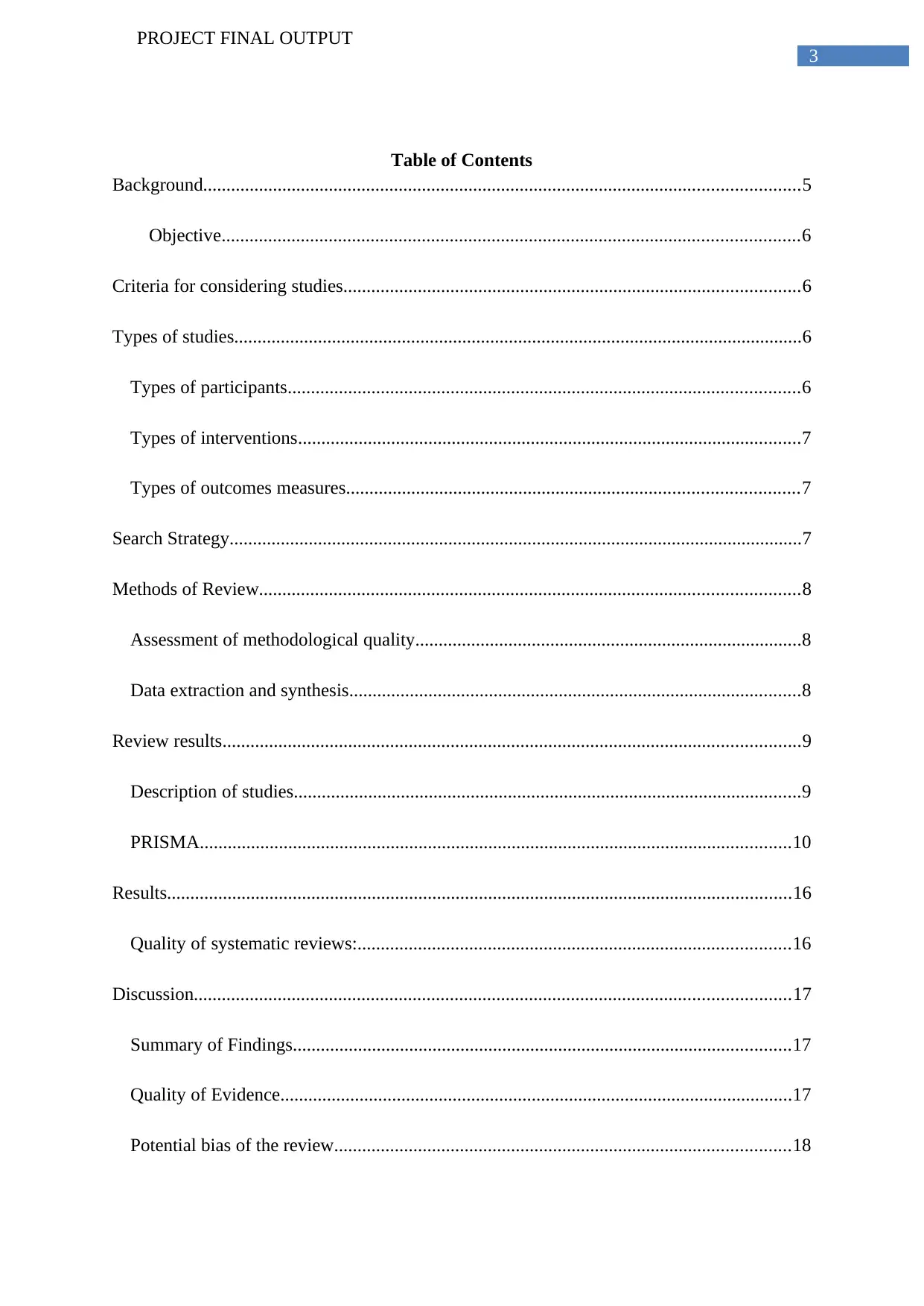
PROJECT FINAL OUTPUT
Table of Contents
Background................................................................................................................................5
Objective............................................................................................................................6
Criteria for considering studies..................................................................................................6
Types of studies..........................................................................................................................6
Types of participants..............................................................................................................6
Types of interventions............................................................................................................7
Types of outcomes measures.................................................................................................7
Search Strategy...........................................................................................................................7
Methods of Review....................................................................................................................8
Assessment of methodological quality...................................................................................8
Data extraction and synthesis.................................................................................................8
Review results............................................................................................................................9
Description of studies.............................................................................................................9
PRISMA...............................................................................................................................10
Results......................................................................................................................................16
Quality of systematic reviews:.............................................................................................16
Discussion................................................................................................................................17
Summary of Findings...........................................................................................................17
Quality of Evidence..............................................................................................................17
Potential bias of the review..................................................................................................18
Paraphrase This Document
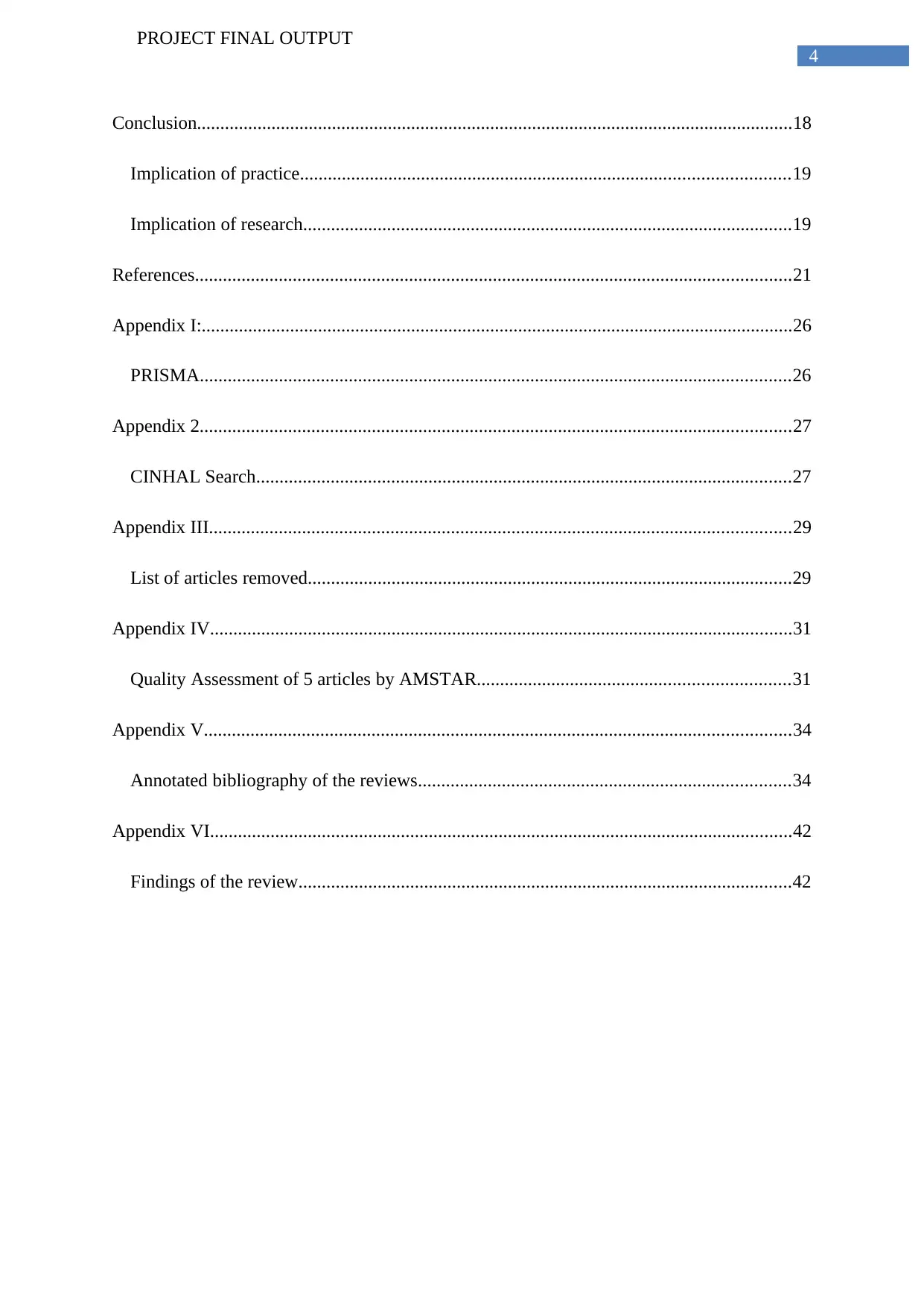
PROJECT FINAL OUTPUT
Conclusion................................................................................................................................18
Implication of practice.........................................................................................................19
Implication of research.........................................................................................................19
References................................................................................................................................21
Appendix I:...............................................................................................................................26
PRISMA...............................................................................................................................26
Appendix 2...............................................................................................................................27
CINHAL Search...................................................................................................................27
Appendix III.............................................................................................................................29
List of articles removed........................................................................................................29
Appendix IV.............................................................................................................................31
Quality Assessment of 5 articles by AMSTAR...................................................................31
Appendix V..............................................................................................................................34
Annotated bibliography of the reviews................................................................................34
Appendix VI.............................................................................................................................42
Findings of the review..........................................................................................................42
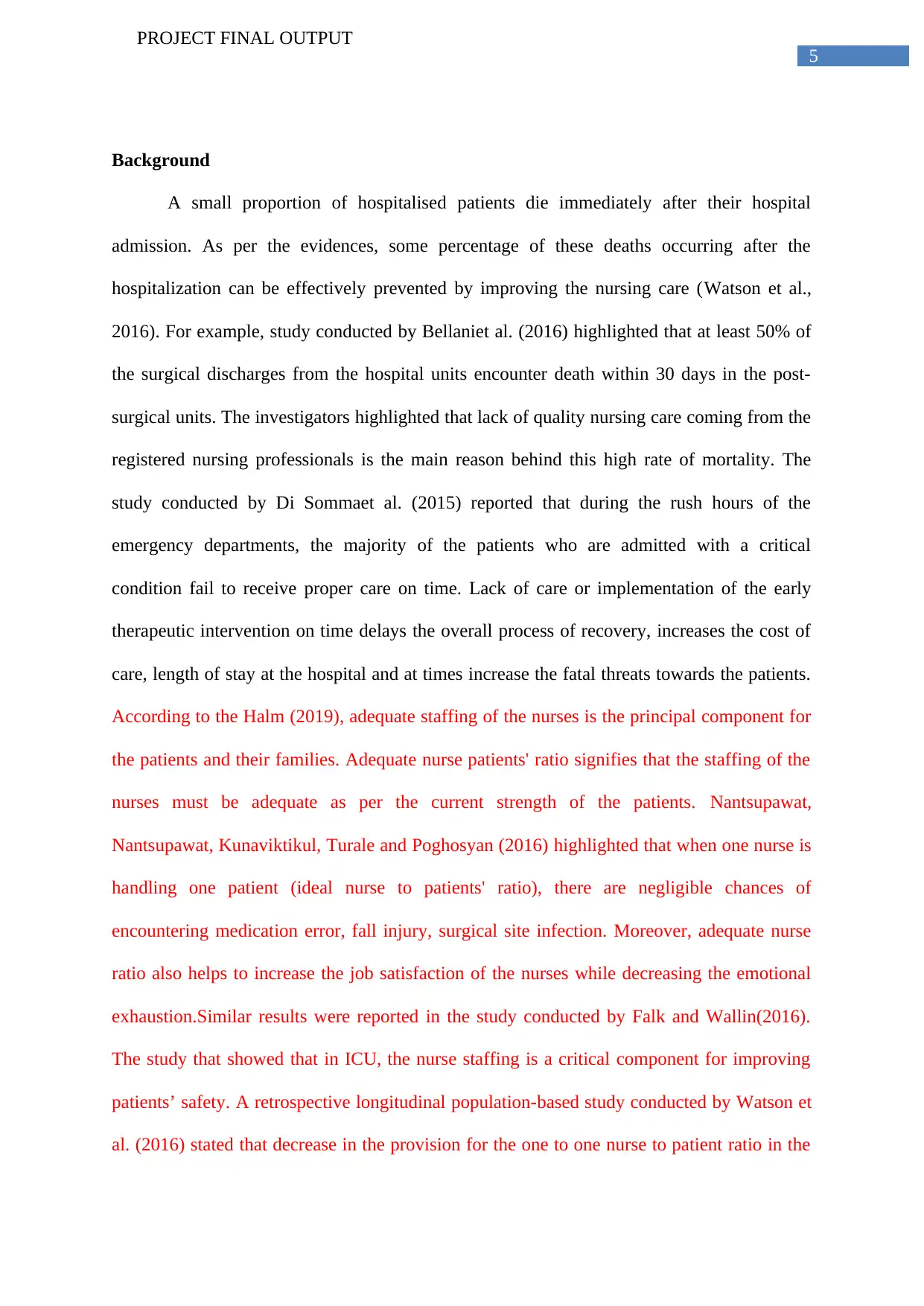
PROJECT FINAL OUTPUT
Background
A small proportion of hospitalised patients die immediately after their hospital
admission. As per the evidences, some percentage of these deaths occurring after the
hospitalization can be effectively prevented by improving the nursing care (Watson et al.,
2016). For example, study conducted by Bellaniet al. (2016) highlighted that at least 50% of
the surgical discharges from the hospital units encounter death within 30 days in the post-
surgical units. The investigators highlighted that lack of quality nursing care coming from the
registered nursing professionals is the main reason behind this high rate of mortality. The
study conducted by Di Sommaet al. (2015) reported that during the rush hours of the
emergency departments, the majority of the patients who are admitted with a critical
condition fail to receive proper care on time. Lack of care or implementation of the early
therapeutic intervention on time delays the overall process of recovery, increases the cost of
care, length of stay at the hospital and at times increase the fatal threats towards the patients.
According to the Halm (2019), adequate staffing of the nurses is the principal component for
the patients and their families. Adequate nurse patients' ratio signifies that the staffing of the
nurses must be adequate as per the current strength of the patients. Nantsupawat,
Nantsupawat, Kunaviktikul, Turale and Poghosyan (2016) highlighted that when one nurse is
handling one patient (ideal nurse to patients' ratio), there are negligible chances of
encountering medication error, fall injury, surgical site infection. Moreover, adequate nurse
ratio also helps to increase the job satisfaction of the nurses while decreasing the emotional
exhaustion.Similar results were reported in the study conducted by Falk and Wallin(2016).
The study that showed that in ICU, the nurse staffing is a critical component for improving
patients’ safety. A retrospective longitudinal population-based study conducted by Watson et
al. (2016) stated that decrease in the provision for the one to one nurse to patient ratio in the
You're viewing a preview
Unlock full access by subscribing today!
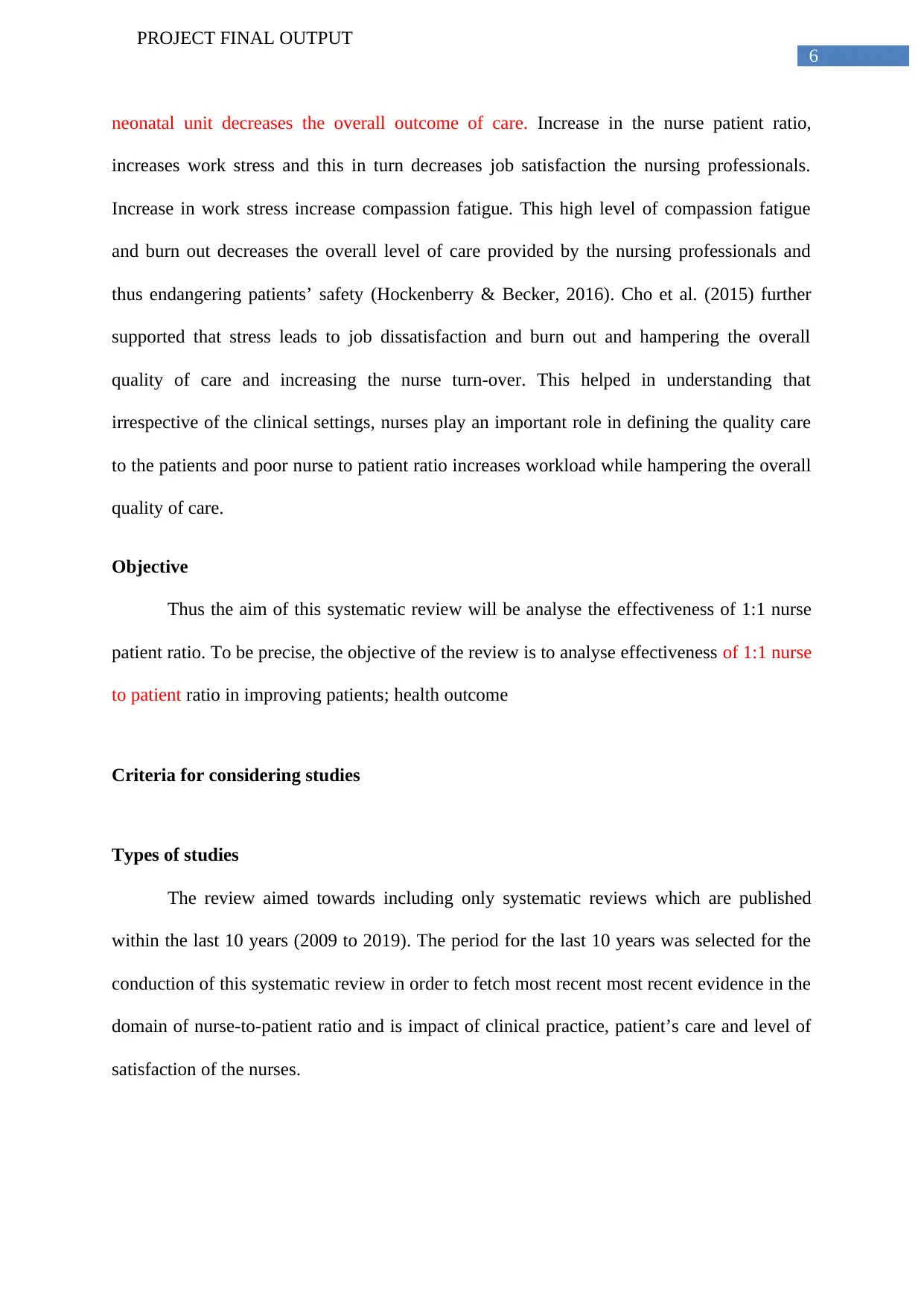
PROJECT FINAL OUTPUT
neonatal unit decreases the overall outcome of care. Increase in the nurse patient ratio,
increases work stress and this in turn decreases job satisfaction the nursing professionals.
Increase in work stress increase compassion fatigue. This high level of compassion fatigue
and burn out decreases the overall level of care provided by the nursing professionals and
thus endangering patients’ safety (Hockenberry & Becker, 2016). Cho et al. (2015) further
supported that stress leads to job dissatisfaction and burn out and hampering the overall
quality of care and increasing the nurse turn-over. This helped in understanding that
irrespective of the clinical settings, nurses play an important role in defining the quality care
to the patients and poor nurse to patient ratio increases workload while hampering the overall
quality of care.
Objective
Thus the aim of this systematic review will be analyse the effectiveness of 1:1 nurse
patient ratio. To be precise, the objective of the review is to analyse effectiveness of 1:1 nurse
to patient ratio in improving patients; health outcome
Criteria for considering studies
Types of studies
The review aimed towards including only systematic reviews which are published
within the last 10 years (2009 to 2019). The period for the last 10 years was selected for the
conduction of this systematic review in order to fetch most recent most recent evidence in the
domain of nurse-to-patient ratio and is impact of clinical practice, patient’s care and level of
satisfaction of the nurses.
Paraphrase This Document
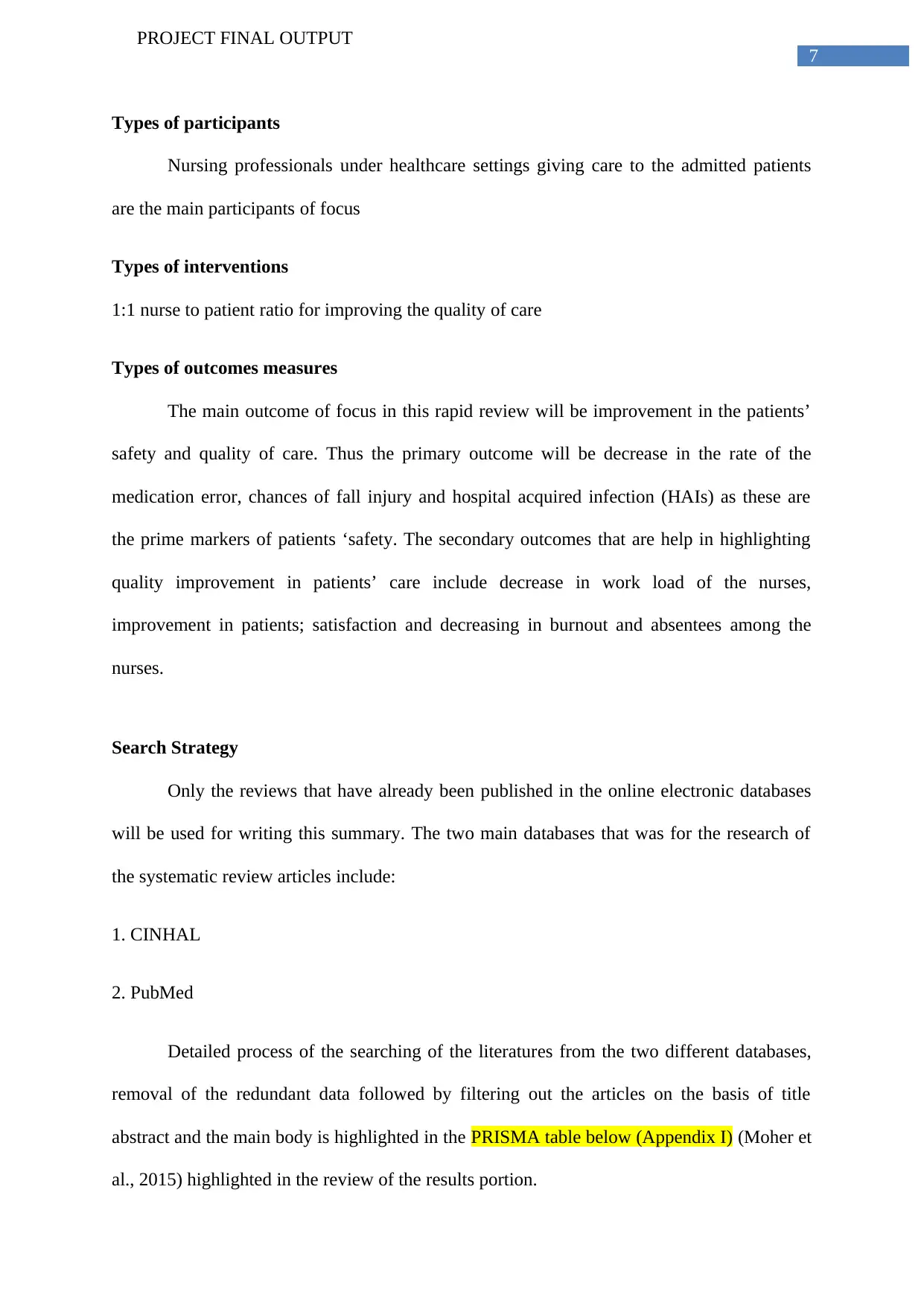
PROJECT FINAL OUTPUT
Types of participants
Nursing professionals under healthcare settings giving care to the admitted patients
are the main participants of focus
Types of interventions
1:1 nurse to patient ratio for improving the quality of care
Types of outcomes measures
The main outcome of focus in this rapid review will be improvement in the patients’
safety and quality of care. Thus the primary outcome will be decrease in the rate of the
medication error, chances of fall injury and hospital acquired infection (HAIs) as these are
the prime markers of patients ‘safety. The secondary outcomes that are help in highlighting
quality improvement in patients’ care include decrease in work load of the nurses,
improvement in patients; satisfaction and decreasing in burnout and absentees among the
nurses.
Search Strategy
Only the reviews that have already been published in the online electronic databases
will be used for writing this summary. The two main databases that was for the research of
the systematic review articles include:
1. CINHAL
2. PubMed
Detailed process of the searching of the literatures from the two different databases,
removal of the redundant data followed by filtering out the articles on the basis of title
abstract and the main body is highlighted in the PRISMA table below (Appendix I) (Moher et
al., 2015) highlighted in the review of the results portion.
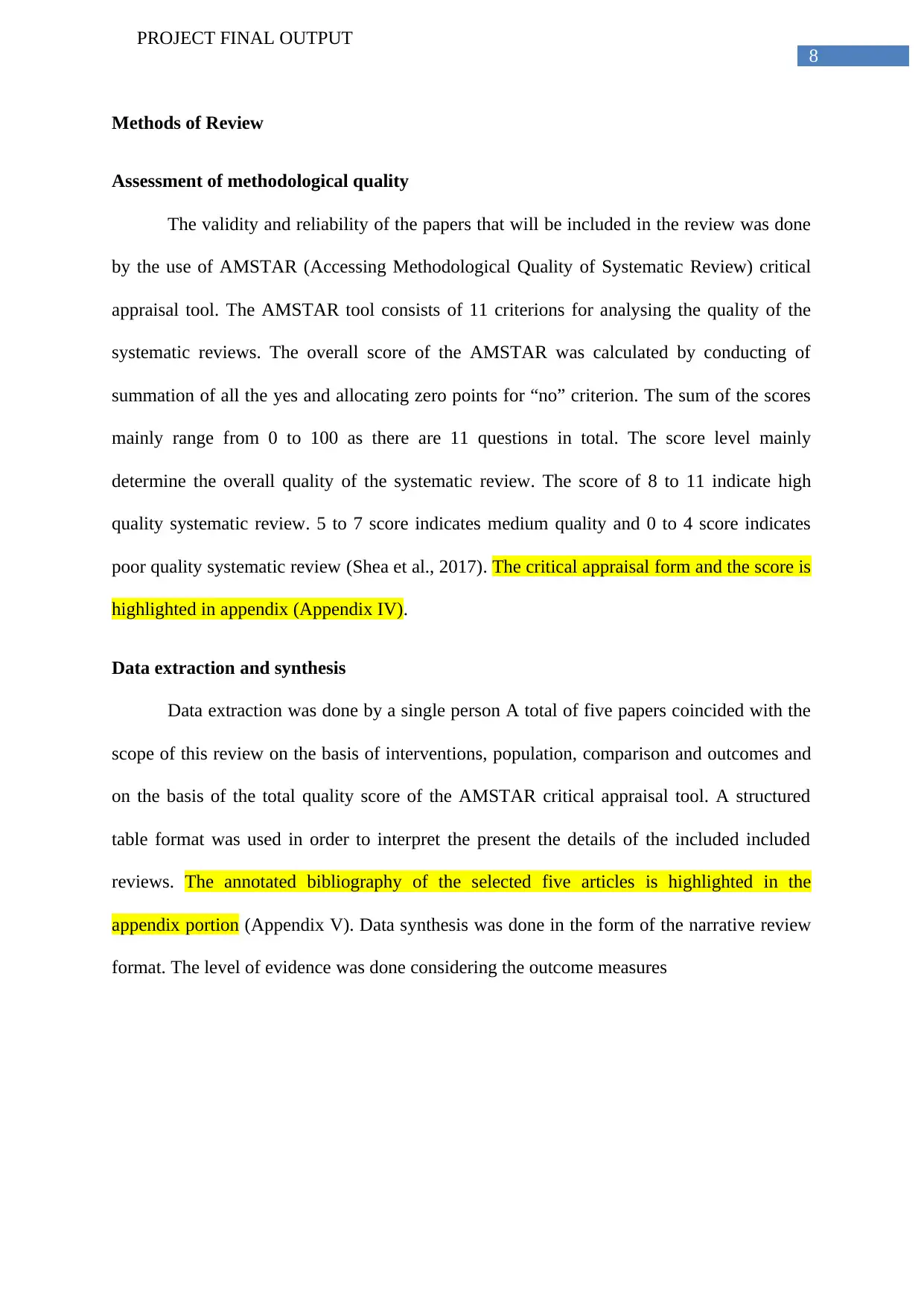
PROJECT FINAL OUTPUT
Methods of Review
Assessment of methodological quality
The validity and reliability of the papers that will be included in the review was done
by the use of AMSTAR (Accessing Methodological Quality of Systematic Review) critical
appraisal tool. The AMSTAR tool consists of 11 criterions for analysing the quality of the
systematic reviews. The overall score of the AMSTAR was calculated by conducting of
summation of all the yes and allocating zero points for “no” criterion. The sum of the scores
mainly range from 0 to 100 as there are 11 questions in total. The score level mainly
determine the overall quality of the systematic review. The score of 8 to 11 indicate high
quality systematic review. 5 to 7 score indicates medium quality and 0 to 4 score indicates
poor quality systematic review (Shea et al., 2017). The critical appraisal form and the score is
highlighted in appendix (Appendix IV).
Data extraction and synthesis
Data extraction was done by a single person A total of five papers coincided with the
scope of this review on the basis of interventions, population, comparison and outcomes and
on the basis of the total quality score of the AMSTAR critical appraisal tool. A structured
table format was used in order to interpret the present the details of the included included
reviews. The annotated bibliography of the selected five articles is highlighted in the
appendix portion (Appendix V). Data synthesis was done in the form of the narrative review
format. The level of evidence was done considering the outcome measures
You're viewing a preview
Unlock full access by subscribing today!
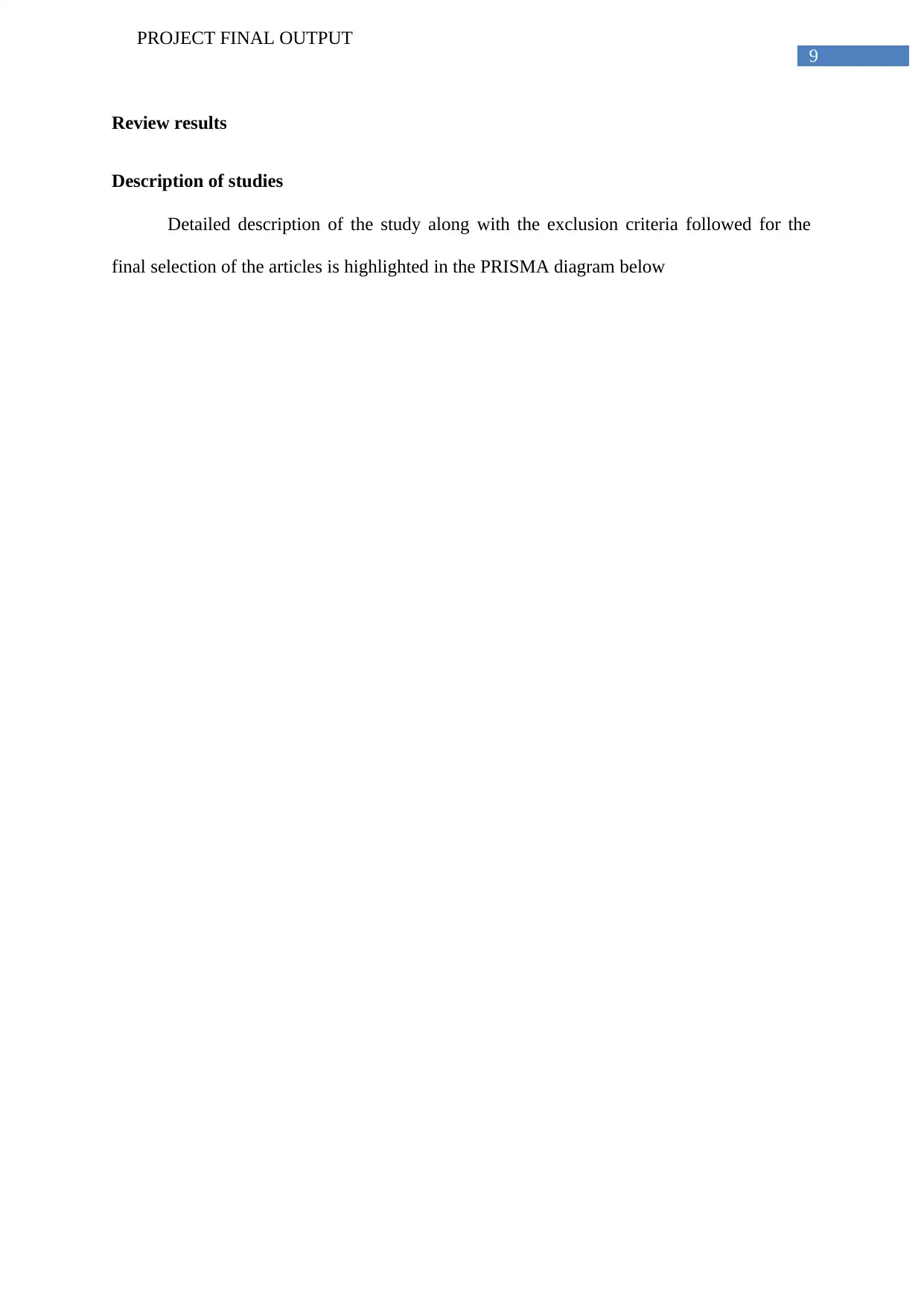
PROJECT FINAL OUTPUT
Review results
Description of studies
Detailed description of the study along with the exclusion criteria followed for the
final selection of the articles is highlighted in the PRISMA diagram below
Paraphrase This Document
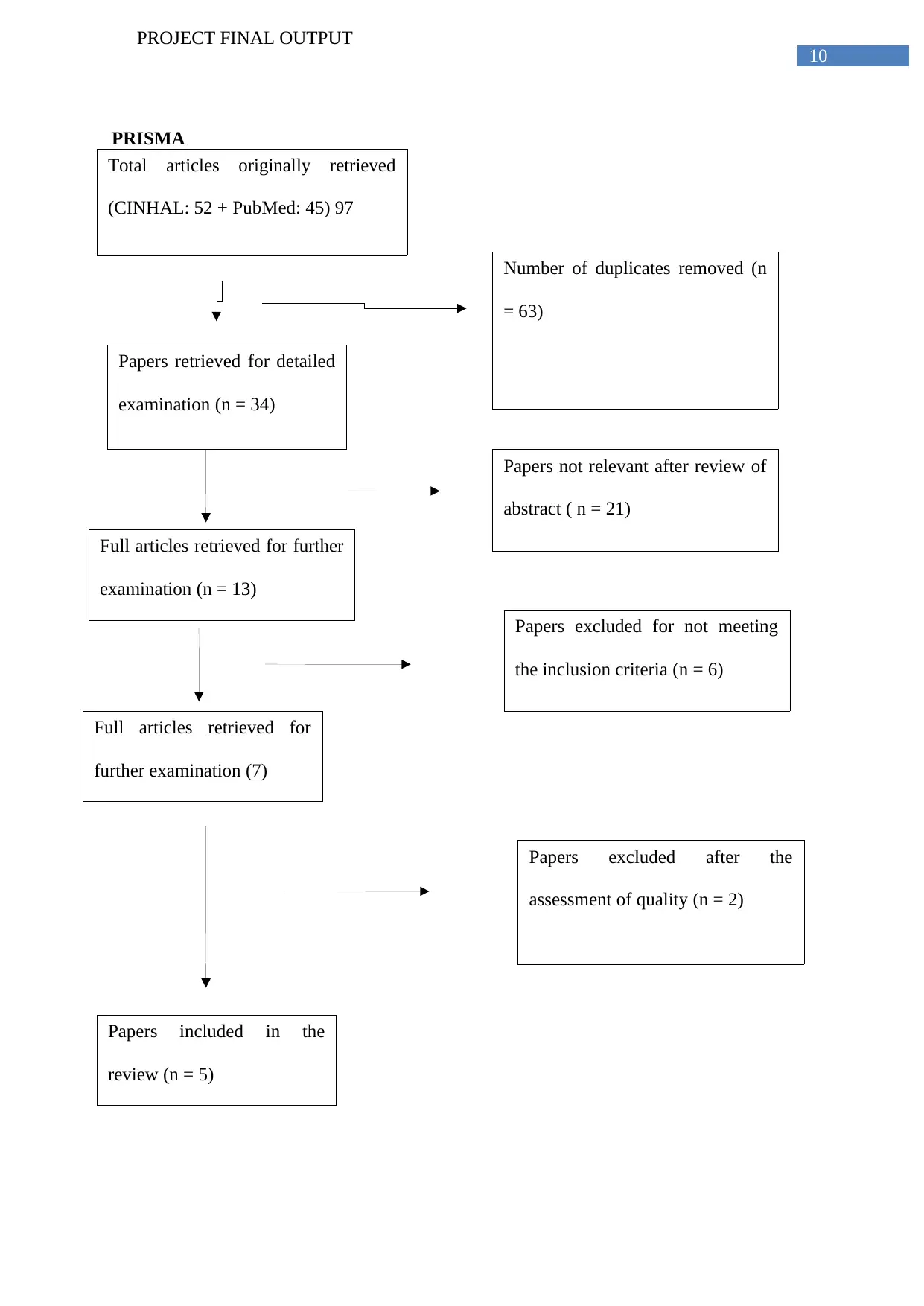
PROJECT FINAL OUTPUT
PRISMA
Total articles originally retrieved
(CINHAL: 52 + PubMed: 45) 97
Number of duplicates removed (n
= 63)
Full articles retrieved for further
examination (n = 13)
Papers not relevant after review of
abstract ( n = 21)
Papers retrieved for detailed
examination (n = 34)
Full articles retrieved for
further examination (7)
Papers included in the
review (n = 5)
Papers excluded for not meeting
the inclusion criteria (n = 6)
Papers excluded after the
assessment of quality (n = 2)

PROJECT FINAL OUTPUT
The first review article that directly coincided with the scope of this review is the
systematic review conducted Shekelle (2013). The aim of the review was conducted to
examine the effect of the nurse staffing ratios and its relation to the in-hospital death. Initially
Shekelle (2013) selected 550 titles of them 87 articles were reviewed. Finally, 15 new studies
that augmented the two existing reviews were included in the main review section. Analysis
of the results highlighted that significant evidence lie supporting a relationship between the
increase in the level of nurse staffing and decrease in the level of in-patients' mortality. These
findings were mainly extracted from the longitudinal studies that were conducted under the
single hospital settings. These findings are in accordance to the study conducted by Hill
(2017) that showed that increase in nurse staffing helps to increase patients’ mortality.also
heThese findings helped to enlighten an important portion of this systematic review object as
it showed that increase in the level of nurse staffing will help to improve the level of
patients’' safety by reducing the hospital related mortality. None of the studies, both
observational and longitudinal studies selected by Shekelle (2013) reported any potential
harm associated with the increase in the level of nurse stuffing in patients' safety related
outcome. In justification of the results elucidated by Shekelle (2013), it can be said that with
the increase in the level of nurse staffing, there occurs decrease in the overall workload of the
nurses. With a decrease in workload of the nurses, the nurses are more likely to execute their
critical thinking skills in highlighting the clinical priority of the post surgical patients and
thus helping to prove early interventions depending on their level of emergency(Halm, 2019).
Moreover, increase in the nurse staffing provide provision for reflective practice for the
nursing professionals this help to highlight the gaps in practice, promotion of team bonding
and thereby helping to decrease the nurse turn-over and improvement in clinical practice
(Twigg & McCullough, 2014). However, review of has certain degree of selection bias. For
You're viewing a preview
Unlock full access by subscribing today!

PROJECT FINAL OUTPUT
example the review included the cross-sectional survey that have poor response rate and this
might lead to over estimation of the treatment efficiency (Howe et al., 2016).
The second systematic review that is selected for this study focused on the ways of
understanding and synthesizing the recent relationships of hospital staffing and the risk of the
hospital acquired infections (HAIs) (Mitchell,Gardner, Stone, Hall &Pogorzelska-Maziarz,
2018). The review includes 54 articles that were selected from the electronic databases like
the MEDLINE, PubMed and CINHAL. The analysis of the results highlighted that at least
92.6% of the selected articles found nurse variables as an important determinants for increase
the patients’ safety in the grounds of hospital-acquired infection. Only 5 to 8% of the studies
showed mixed results. Overall, the authors concluded that increase in the level of nurse
staffing helps to decrease the overall risk of acquiring of HAIs. Though this review do not
provide direct evidence towards the importance of 1:1 nurse patients’ ratio, but it helps in
understanding how the increase the level of nurse staffing helps to reduce the chances of the
HAIs. Zimlichmanet al. (2013) stated the HAIs is one of the important concern among the
hospital patients that to only increases the cost of care but also decreases the health-related
outcome of the patients while extending the length of stay at the hospital. For a patients; who
is immune-compromised (cancer patients) development of the hospital acquired infection is
fatal and thus endangering patients’ safety. Magill et al. (2014) also showed in the study that
increasing nurse staffing reduce the work load and thus enabling the nurse to use personal
protective equipments and observance of the hand hygiene in handling sensitive patients and
thereby helping to improve the overall outcome of patients’ care. One of the methodological
limitations of the study is selection bias or publication bias. In order to increase the sample
size of the study, Mitchell,Gardner, Stone, Hall and Pogorzelska-Maziarz (2018) failed to
exclude the non-peer reviewed journals and also include policy statement and editorial. This
hampered the rigor and consistency of the study. Moreover, hospital infrastructure
Paraphrase This Document
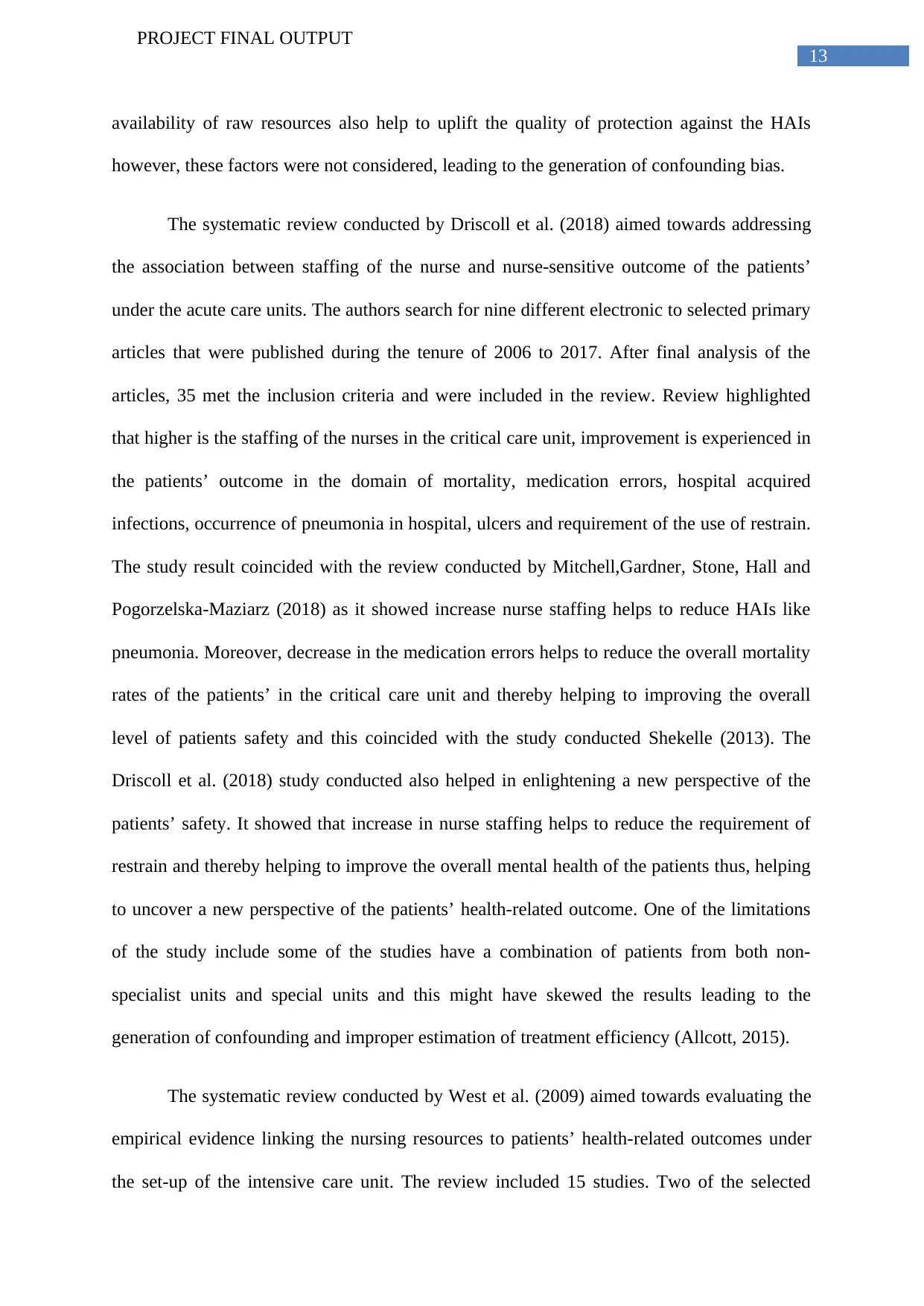
PROJECT FINAL OUTPUT
availability of raw resources also help to uplift the quality of protection against the HAIs
however, these factors were not considered, leading to the generation of confounding bias.
The systematic review conducted by Driscoll et al. (2018) aimed towards addressing
the association between staffing of the nurse and nurse-sensitive outcome of the patients’
under the acute care units. The authors search for nine different electronic to selected primary
articles that were published during the tenure of 2006 to 2017. After final analysis of the
articles, 35 met the inclusion criteria and were included in the review. Review highlighted
that higher is the staffing of the nurses in the critical care unit, improvement is experienced in
the patients’ outcome in the domain of mortality, medication errors, hospital acquired
infections, occurrence of pneumonia in hospital, ulcers and requirement of the use of restrain.
The study result coincided with the review conducted by Mitchell,Gardner, Stone, Hall and
Pogorzelska-Maziarz (2018) as it showed increase nurse staffing helps to reduce HAIs like
pneumonia. Moreover, decrease in the medication errors helps to reduce the overall mortality
rates of the patients’ in the critical care unit and thereby helping to improving the overall
level of patients safety and this coincided with the study conducted Shekelle (2013). The
Driscoll et al. (2018) study conducted also helped in enlightening a new perspective of the
patients’ safety. It showed that increase in nurse staffing helps to reduce the requirement of
restrain and thereby helping to improve the overall mental health of the patients thus, helping
to uncover a new perspective of the patients’ health-related outcome. One of the limitations
of the study include some of the studies have a combination of patients from both non-
specialist units and special units and this might have skewed the results leading to the
generation of confounding and improper estimation of treatment efficiency (Allcott, 2015).
The systematic review conducted by West et al. (2009) aimed towards evaluating the
empirical evidence linking the nursing resources to patients’ health-related outcomes under
the set-up of the intensive care unit. The review included 15 studies. Two of the selected
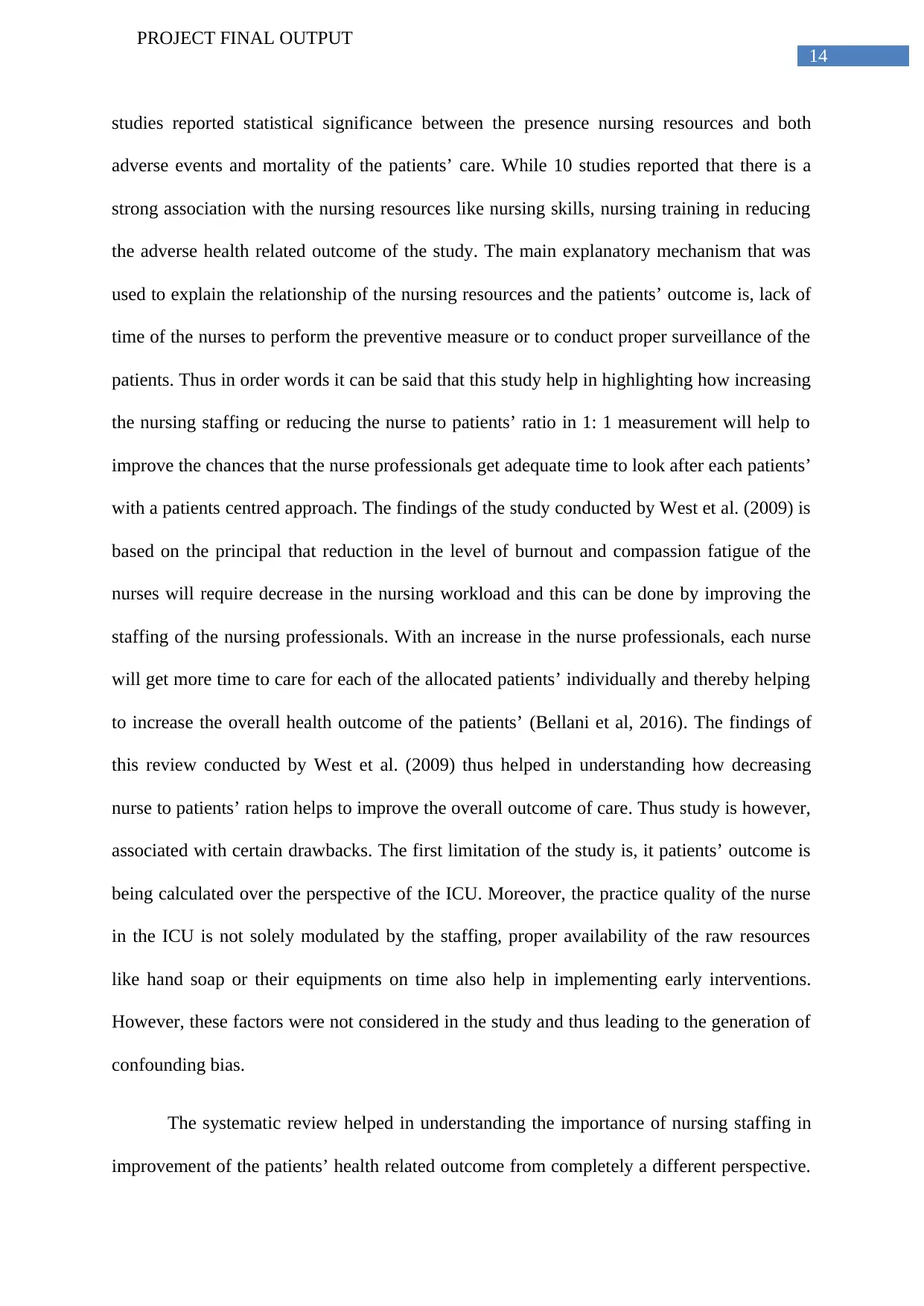
PROJECT FINAL OUTPUT
studies reported statistical significance between the presence nursing resources and both
adverse events and mortality of the patients’ care. While 10 studies reported that there is a
strong association with the nursing resources like nursing skills, nursing training in reducing
the adverse health related outcome of the study. The main explanatory mechanism that was
used to explain the relationship of the nursing resources and the patients’ outcome is, lack of
time of the nurses to perform the preventive measure or to conduct proper surveillance of the
patients. Thus in order words it can be said that this study help in highlighting how increasing
the nursing staffing or reducing the nurse to patients’ ratio in 1: 1 measurement will help to
improve the chances that the nurse professionals get adequate time to look after each patients’
with a patients centred approach. The findings of the study conducted by West et al. (2009) is
based on the principal that reduction in the level of burnout and compassion fatigue of the
nurses will require decrease in the nursing workload and this can be done by improving the
staffing of the nursing professionals. With an increase in the nurse professionals, each nurse
will get more time to care for each of the allocated patients’ individually and thereby helping
to increase the overall health outcome of the patients’ (Bellani et al, 2016). The findings of
this review conducted by West et al. (2009) thus helped in understanding how decreasing
nurse to patients’ ration helps to improve the overall outcome of care. Thus study is however,
associated with certain drawbacks. The first limitation of the study is, it patients’ outcome is
being calculated over the perspective of the ICU. Moreover, the practice quality of the nurse
in the ICU is not solely modulated by the staffing, proper availability of the raw resources
like hand soap or their equipments on time also help in implementing early interventions.
However, these factors were not considered in the study and thus leading to the generation of
confounding bias.
The systematic review helped in understanding the importance of nursing staffing in
improvement of the patients’ health related outcome from completely a different perspective.
You're viewing a preview
Unlock full access by subscribing today!
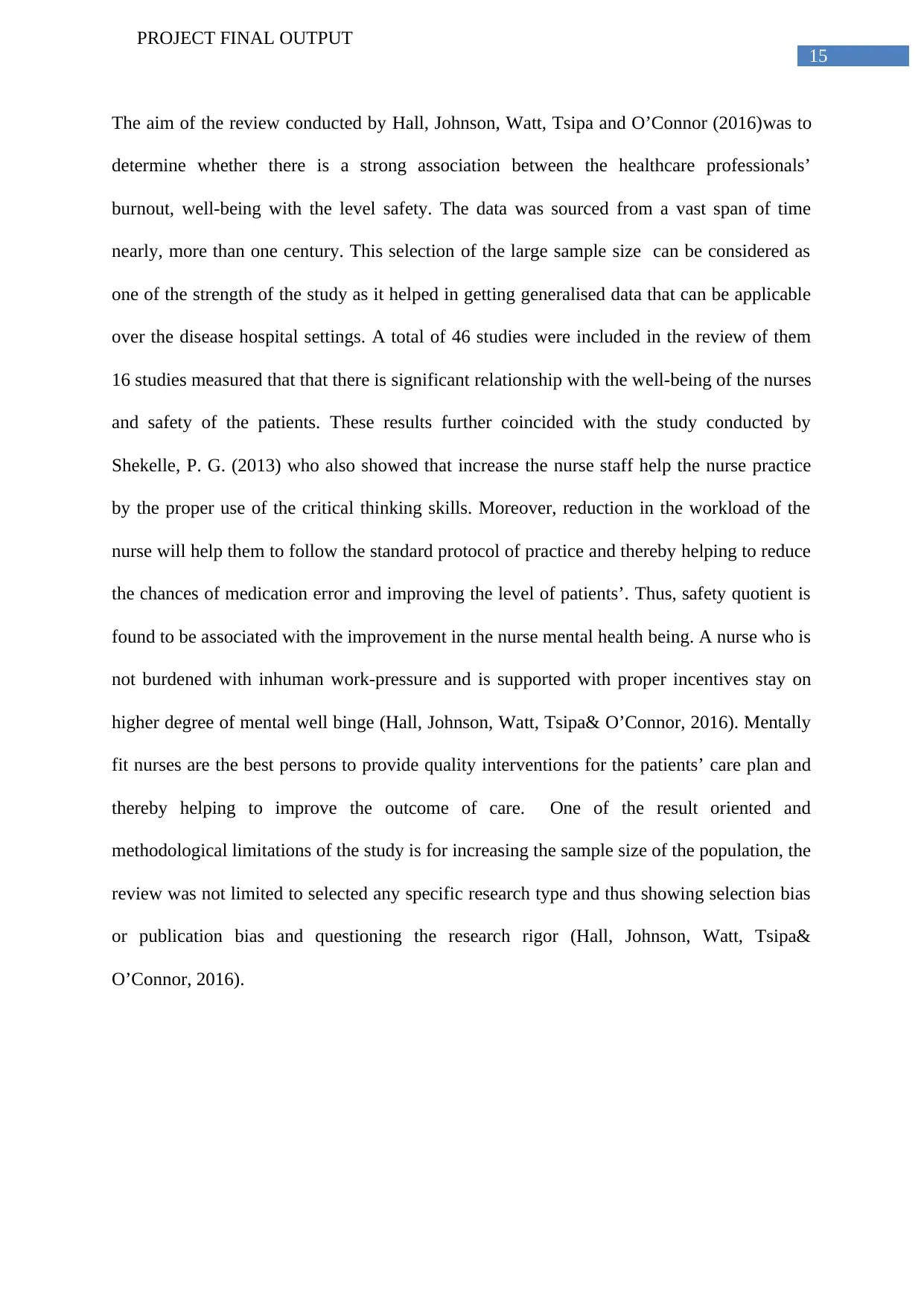
PROJECT FINAL OUTPUT
The aim of the review conducted by Hall, Johnson, Watt, Tsipa and O’Connor (2016)was to
determine whether there is a strong association between the healthcare professionals’
burnout, well-being with the level safety. The data was sourced from a vast span of time
nearly, more than one century. This selection of the large sample size can be considered as
one of the strength of the study as it helped in getting generalised data that can be applicable
over the disease hospital settings. A total of 46 studies were included in the review of them
16 studies measured that that there is significant relationship with the well-being of the nurses
and safety of the patients. These results further coincided with the study conducted by
Shekelle, P. G. (2013) who also showed that increase the nurse staff help the nurse practice
by the proper use of the critical thinking skills. Moreover, reduction in the workload of the
nurse will help them to follow the standard protocol of practice and thereby helping to reduce
the chances of medication error and improving the level of patients’. Thus, safety quotient is
found to be associated with the improvement in the nurse mental health being. A nurse who is
not burdened with inhuman work-pressure and is supported with proper incentives stay on
higher degree of mental well binge (Hall, Johnson, Watt, Tsipa& O’Connor, 2016). Mentally
fit nurses are the best persons to provide quality interventions for the patients’ care plan and
thereby helping to improve the outcome of care. One of the result oriented and
methodological limitations of the study is for increasing the sample size of the population, the
review was not limited to selected any specific research type and thus showing selection bias
or publication bias and questioning the research rigor (Hall, Johnson, Watt, Tsipa&
O’Connor, 2016).
Paraphrase This Document
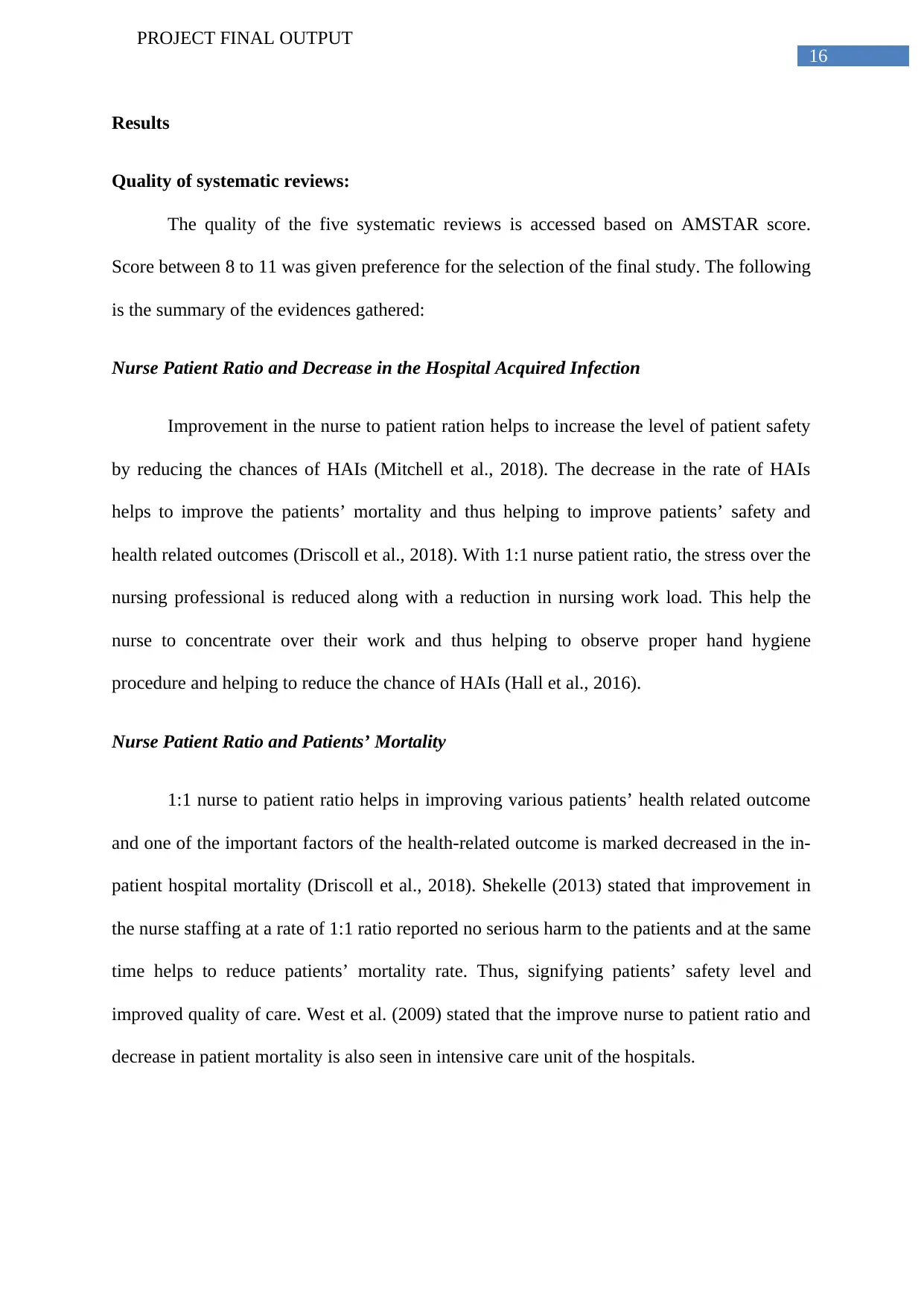
PROJECT FINAL OUTPUT
Results
Quality of systematic reviews:
The quality of the five systematic reviews is accessed based on AMSTAR score.
Score between 8 to 11 was given preference for the selection of the final study. The following
is the summary of the evidences gathered:
Nurse Patient Ratio and Decrease in the Hospital Acquired Infection
Improvement in the nurse to patient ration helps to increase the level of patient safety
by reducing the chances of HAIs (Mitchell et al., 2018). The decrease in the rate of HAIs
helps to improve the patients’ mortality and thus helping to improve patients’ safety and
health related outcomes (Driscoll et al., 2018). With 1:1 nurse patient ratio, the stress over the
nursing professional is reduced along with a reduction in nursing work load. This help the
nurse to concentrate over their work and thus helping to observe proper hand hygiene
procedure and helping to reduce the chance of HAIs (Hall et al., 2016).
Nurse Patient Ratio and Patients’ Mortality
1:1 nurse to patient ratio helps in improving various patients’ health related outcome
and one of the important factors of the health-related outcome is marked decreased in the in-
patient hospital mortality (Driscoll et al., 2018). Shekelle (2013) stated that improvement in
the nurse staffing at a rate of 1:1 ratio reported no serious harm to the patients and at the same
time helps to reduce patients’ mortality rate. Thus, signifying patients’ safety level and
improved quality of care. West et al. (2009) stated that the improve nurse to patient ratio and
decrease in patient mortality is also seen in intensive care unit of the hospitals.
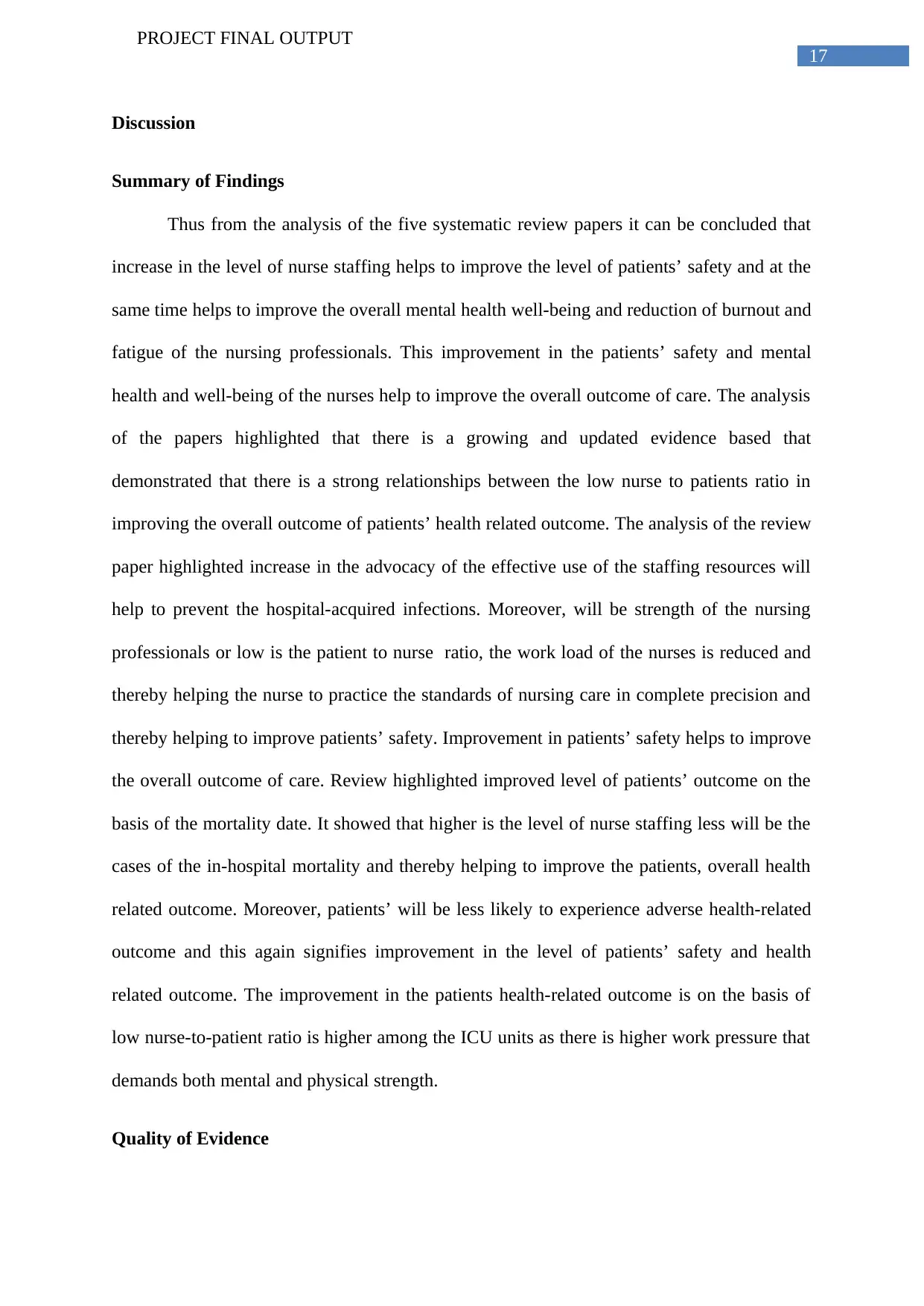
PROJECT FINAL OUTPUT
Discussion
Summary of Findings
Thus from the analysis of the five systematic review papers it can be concluded that
increase in the level of nurse staffing helps to improve the level of patients’ safety and at the
same time helps to improve the overall mental health well-being and reduction of burnout and
fatigue of the nursing professionals. This improvement in the patients’ safety and mental
health and well-being of the nurses help to improve the overall outcome of care. The analysis
of the papers highlighted that there is a growing and updated evidence based that
demonstrated that there is a strong relationships between the low nurse to patients ratio in
improving the overall outcome of patients’ health related outcome. The analysis of the review
paper highlighted increase in the advocacy of the effective use of the staffing resources will
help to prevent the hospital-acquired infections. Moreover, will be strength of the nursing
professionals or low is the patient to nurse ratio, the work load of the nurses is reduced and
thereby helping the nurse to practice the standards of nursing care in complete precision and
thereby helping to improve patients’ safety. Improvement in patients’ safety helps to improve
the overall outcome of care. Review highlighted improved level of patients’ outcome on the
basis of the mortality date. It showed that higher is the level of nurse staffing less will be the
cases of the in-hospital mortality and thereby helping to improve the patients, overall health
related outcome. Moreover, patients’ will be less likely to experience adverse health-related
outcome and this again signifies improvement in the level of patients’ safety and health
related outcome. The improvement in the patients health-related outcome is on the basis of
low nurse-to-patient ratio is higher among the ICU units as there is higher work pressure that
demands both mental and physical strength.
Quality of Evidence
You're viewing a preview
Unlock full access by subscribing today!
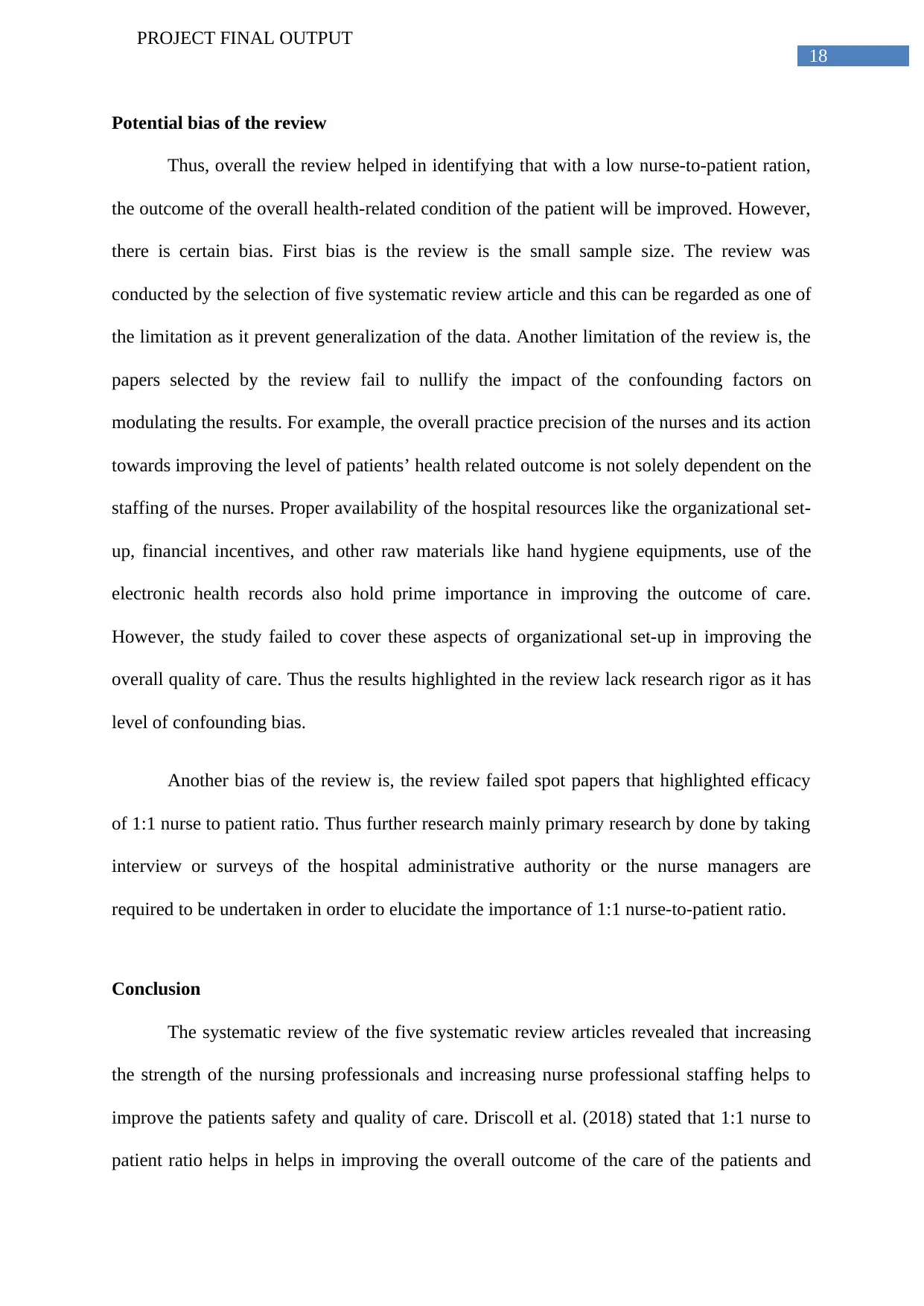
PROJECT FINAL OUTPUT
Potential bias of the review
Thus, overall the review helped in identifying that with a low nurse-to-patient ration,
the outcome of the overall health-related condition of the patient will be improved. However,
there is certain bias. First bias is the review is the small sample size. The review was
conducted by the selection of five systematic review article and this can be regarded as one of
the limitation as it prevent generalization of the data. Another limitation of the review is, the
papers selected by the review fail to nullify the impact of the confounding factors on
modulating the results. For example, the overall practice precision of the nurses and its action
towards improving the level of patients’ health related outcome is not solely dependent on the
staffing of the nurses. Proper availability of the hospital resources like the organizational set-
up, financial incentives, and other raw materials like hand hygiene equipments, use of the
electronic health records also hold prime importance in improving the outcome of care.
However, the study failed to cover these aspects of organizational set-up in improving the
overall quality of care. Thus the results highlighted in the review lack research rigor as it has
level of confounding bias.
Another bias of the review is, the review failed spot papers that highlighted efficacy
of 1:1 nurse to patient ratio. Thus further research mainly primary research by done by taking
interview or surveys of the hospital administrative authority or the nurse managers are
required to be undertaken in order to elucidate the importance of 1:1 nurse-to-patient ratio.
Conclusion
The systematic review of the five systematic review articles revealed that increasing
the strength of the nursing professionals and increasing nurse professional staffing helps to
improve the patients safety and quality of care. Driscoll et al. (2018) stated that 1:1 nurse to
patient ratio helps in helps in improving the overall outcome of the care of the patients and
Paraphrase This Document
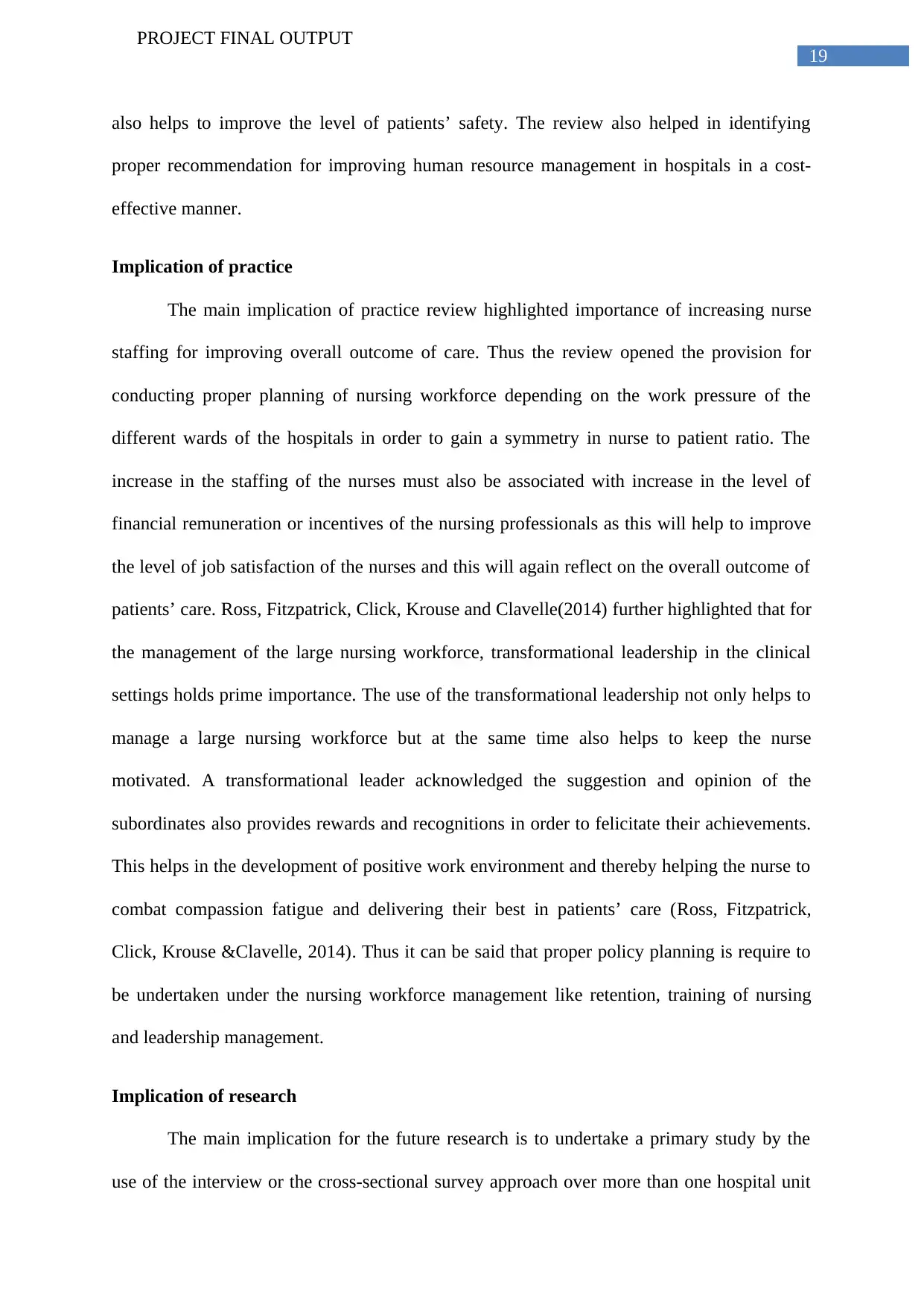
PROJECT FINAL OUTPUT
also helps to improve the level of patients’ safety. The review also helped in identifying
proper recommendation for improving human resource management in hospitals in a cost-
effective manner.
Implication of practice
The main implication of practice review highlighted importance of increasing nurse
staffing for improving overall outcome of care. Thus the review opened the provision for
conducting proper planning of nursing workforce depending on the work pressure of the
different wards of the hospitals in order to gain a symmetry in nurse to patient ratio. The
increase in the staffing of the nurses must also be associated with increase in the level of
financial remuneration or incentives of the nursing professionals as this will help to improve
the level of job satisfaction of the nurses and this will again reflect on the overall outcome of
patients’ care. Ross, Fitzpatrick, Click, Krouse and Clavelle(2014) further highlighted that for
the management of the large nursing workforce, transformational leadership in the clinical
settings holds prime importance. The use of the transformational leadership not only helps to
manage a large nursing workforce but at the same time also helps to keep the nurse
motivated. A transformational leader acknowledged the suggestion and opinion of the
subordinates also provides rewards and recognitions in order to felicitate their achievements.
This helps in the development of positive work environment and thereby helping the nurse to
combat compassion fatigue and delivering their best in patients’ care (Ross, Fitzpatrick,
Click, Krouse &Clavelle, 2014). Thus it can be said that proper policy planning is require to
be undertaken under the nursing workforce management like retention, training of nursing
and leadership management.
Implication of research
The main implication for the future research is to undertake a primary study by the
use of the interview or the cross-sectional survey approach over more than one hospital unit
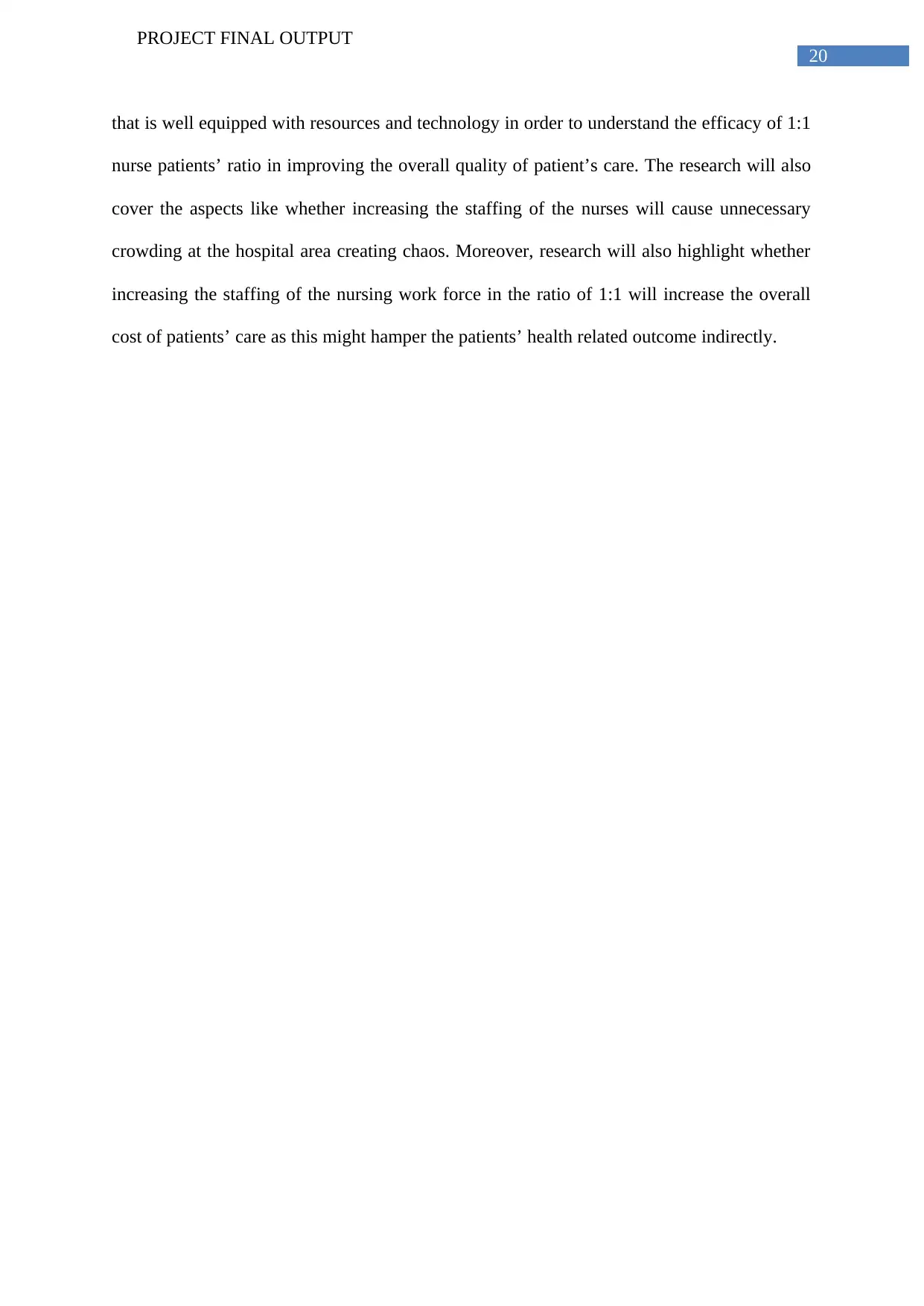
PROJECT FINAL OUTPUT
that is well equipped with resources and technology in order to understand the efficacy of 1:1
nurse patients’ ratio in improving the overall quality of patient’s care. The research will also
cover the aspects like whether increasing the staffing of the nurses will cause unnecessary
crowding at the hospital area creating chaos. Moreover, research will also highlight whether
increasing the staffing of the nursing work force in the ratio of 1:1 will increase the overall
cost of patients’ care as this might hamper the patients’ health related outcome indirectly.
You're viewing a preview
Unlock full access by subscribing today!
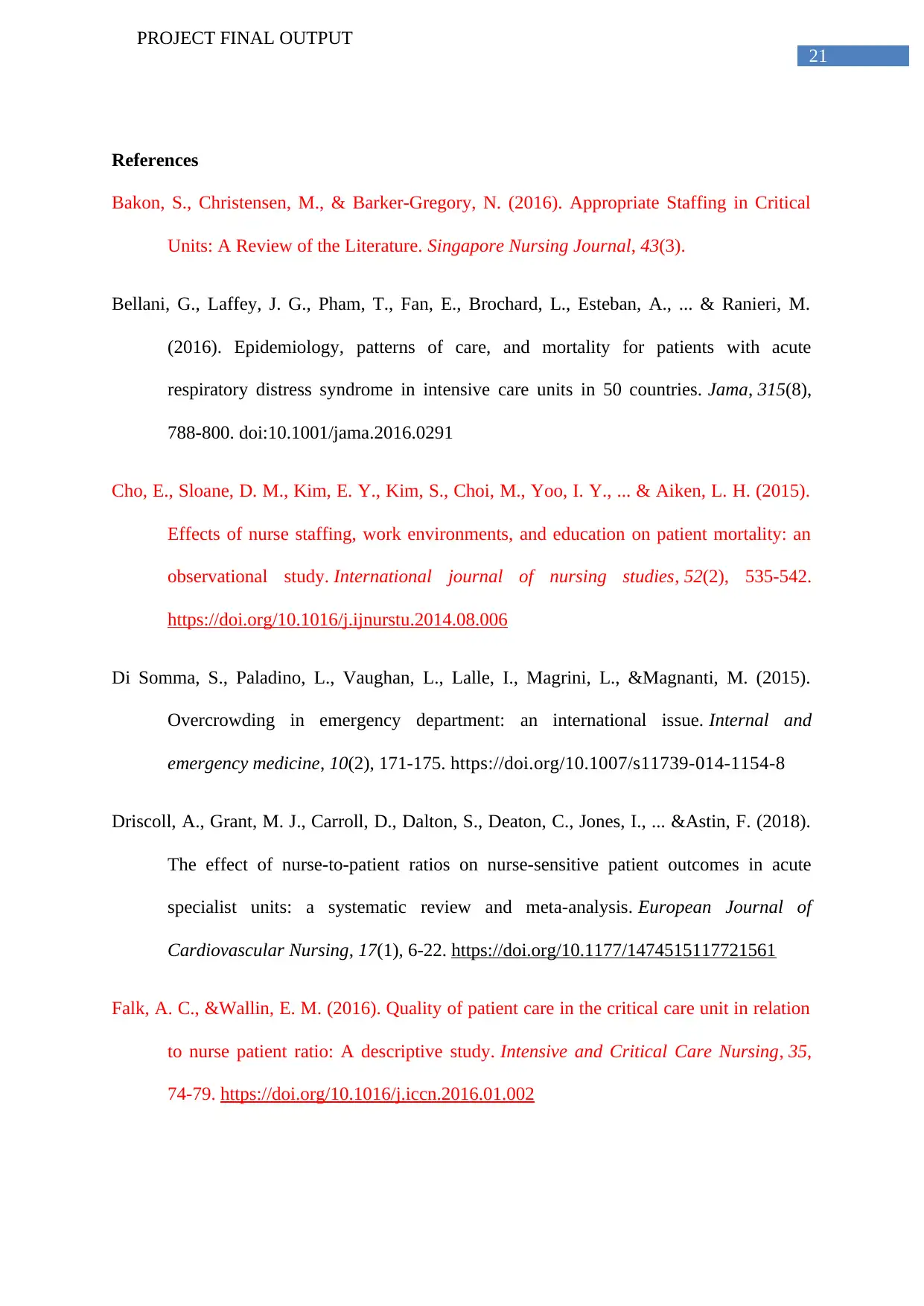
PROJECT FINAL OUTPUT
References
Bakon, S., Christensen, M., & Barker-Gregory, N. (2016). Appropriate Staffing in Critical
Units: A Review of the Literature. Singapore Nursing Journal, 43(3).
Bellani, G., Laffey, J. G., Pham, T., Fan, E., Brochard, L., Esteban, A., ... & Ranieri, M.
(2016). Epidemiology, patterns of care, and mortality for patients with acute
respiratory distress syndrome in intensive care units in 50 countries. Jama, 315(8),
788-800. doi:10.1001/jama.2016.0291
Cho, E., Sloane, D. M., Kim, E. Y., Kim, S., Choi, M., Yoo, I. Y., ... & Aiken, L. H. (2015).
Effects of nurse staffing, work environments, and education on patient mortality: an
observational study. International journal of nursing studies, 52(2), 535-542.
https://doi.org/10.1016/j.ijnurstu.2014.08.006
Di Somma, S., Paladino, L., Vaughan, L., Lalle, I., Magrini, L., &Magnanti, M. (2015).
Overcrowding in emergency department: an international issue. Internal and
emergency medicine, 10(2), 171-175. https://doi.org/10.1007/s11739-014-1154-8
Driscoll, A., Grant, M. J., Carroll, D., Dalton, S., Deaton, C., Jones, I., ... &Astin, F. (2018).
The effect of nurse-to-patient ratios on nurse-sensitive patient outcomes in acute
specialist units: a systematic review and meta-analysis. European Journal of
Cardiovascular Nursing, 17(1), 6-22. https://doi.org/10.1177/1474515117721561
Falk, A. C., &Wallin, E. M. (2016). Quality of patient care in the critical care unit in relation
to nurse patient ratio: A descriptive study. Intensive and Critical Care Nursing, 35,
74-79. https://doi.org/10.1016/j.iccn.2016.01.002
Paraphrase This Document
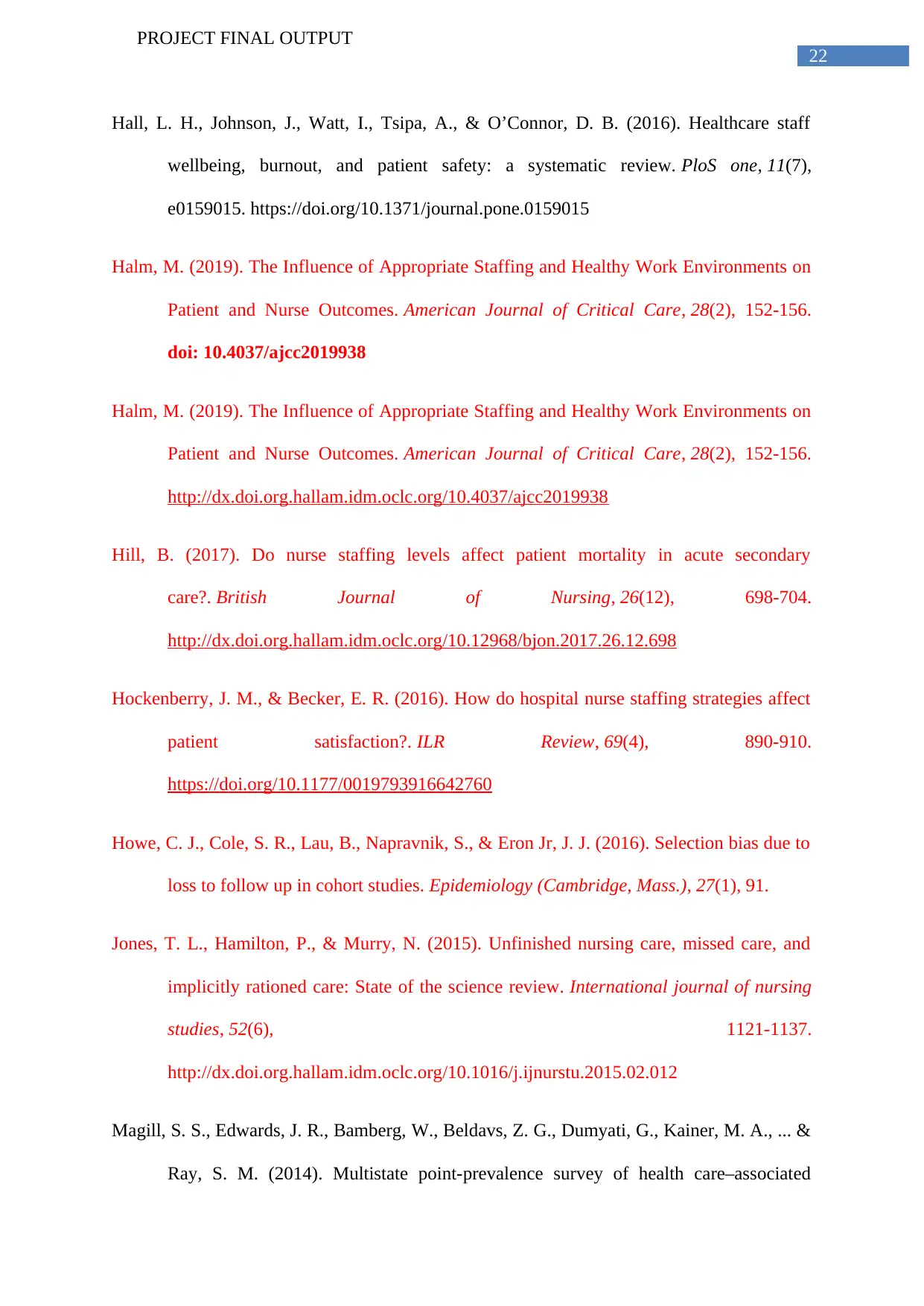
PROJECT FINAL OUTPUT
Hall, L. H., Johnson, J., Watt, I., Tsipa, A., & O’Connor, D. B. (2016). Healthcare staff
wellbeing, burnout, and patient safety: a systematic review. PloS one, 11(7),
e0159015. https://doi.org/10.1371/journal.pone.0159015
Halm, M. (2019). The Influence of Appropriate Staffing and Healthy Work Environments on
Patient and Nurse Outcomes. American Journal of Critical Care, 28(2), 152-156.
doi: 10.4037/ajcc2019938
Halm, M. (2019). The Influence of Appropriate Staffing and Healthy Work Environments on
Patient and Nurse Outcomes. American Journal of Critical Care, 28(2), 152-156.
http://dx.doi.org.hallam.idm.oclc.org/10.4037/ajcc2019938
Hill, B. (2017). Do nurse staffing levels affect patient mortality in acute secondary
care?. British Journal of Nursing, 26(12), 698-704.
http://dx.doi.org.hallam.idm.oclc.org/10.12968/bjon.2017.26.12.698
Hockenberry, J. M., & Becker, E. R. (2016). How do hospital nurse staffing strategies affect
patient satisfaction?. ILR Review, 69(4), 890-910.
https://doi.org/10.1177/0019793916642760
Howe, C. J., Cole, S. R., Lau, B., Napravnik, S., & Eron Jr, J. J. (2016). Selection bias due to
loss to follow up in cohort studies. Epidemiology (Cambridge, Mass.), 27(1), 91.
Jones, T. L., Hamilton, P., & Murry, N. (2015). Unfinished nursing care, missed care, and
implicitly rationed care: State of the science review. International journal of nursing
studies, 52(6), 1121-1137.
http://dx.doi.org.hallam.idm.oclc.org/10.1016/j.ijnurstu.2015.02.012
Magill, S. S., Edwards, J. R., Bamberg, W., Beldavs, Z. G., Dumyati, G., Kainer, M. A., ... &
Ray, S. M. (2014). Multistate point-prevalence survey of health care–associated
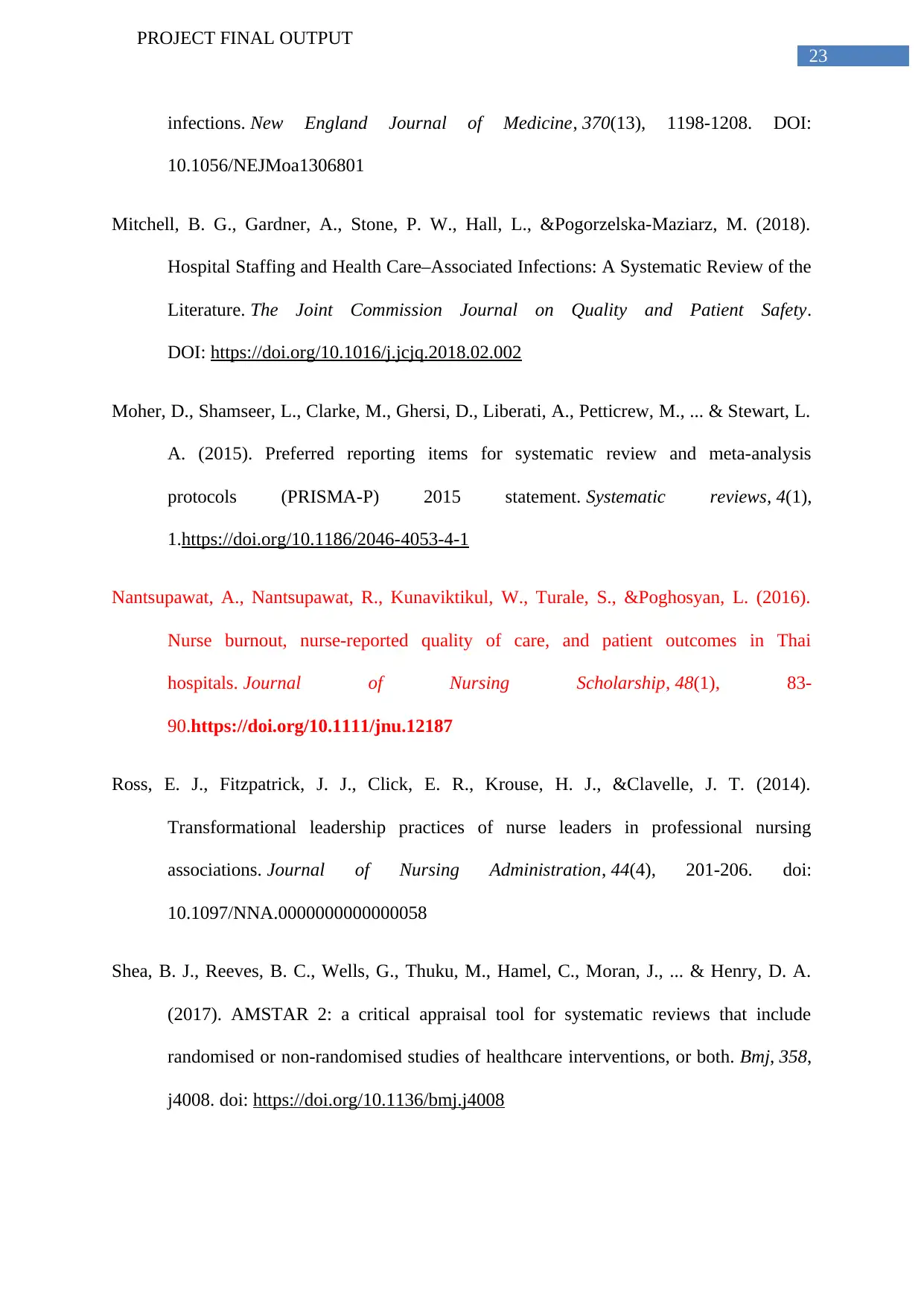
PROJECT FINAL OUTPUT
infections. New England Journal of Medicine, 370(13), 1198-1208. DOI:
10.1056/NEJMoa1306801
Mitchell, B. G., Gardner, A., Stone, P. W., Hall, L., &Pogorzelska-Maziarz, M. (2018).
Hospital Staffing and Health Care–Associated Infections: A Systematic Review of the
Literature. The Joint Commission Journal on Quality and Patient Safety.
DOI: https://doi.org/10.1016/j.jcjq.2018.02.002
Moher, D., Shamseer, L., Clarke, M., Ghersi, D., Liberati, A., Petticrew, M., ... & Stewart, L.
A. (2015). Preferred reporting items for systematic review and meta-analysis
protocols (PRISMA-P) 2015 statement. Systematic reviews, 4(1),
1.https://doi.org/10.1186/2046-4053-4-1
Nantsupawat, A., Nantsupawat, R., Kunaviktikul, W., Turale, S., &Poghosyan, L. (2016).
Nurse burnout, nurse‐reported quality of care, and patient outcomes in Thai
hospitals. Journal of Nursing Scholarship, 48(1), 83-
90.https://doi.org/10.1111/jnu.12187
Ross, E. J., Fitzpatrick, J. J., Click, E. R., Krouse, H. J., &Clavelle, J. T. (2014).
Transformational leadership practices of nurse leaders in professional nursing
associations. Journal of Nursing Administration, 44(4), 201-206. doi:
10.1097/NNA.0000000000000058
Shea, B. J., Reeves, B. C., Wells, G., Thuku, M., Hamel, C., Moran, J., ... & Henry, D. A.
(2017). AMSTAR 2: a critical appraisal tool for systematic reviews that include
randomised or non-randomised studies of healthcare interventions, or both. Bmj, 358,
j4008. doi: https://doi.org/10.1136/bmj.j4008
You're viewing a preview
Unlock full access by subscribing today!
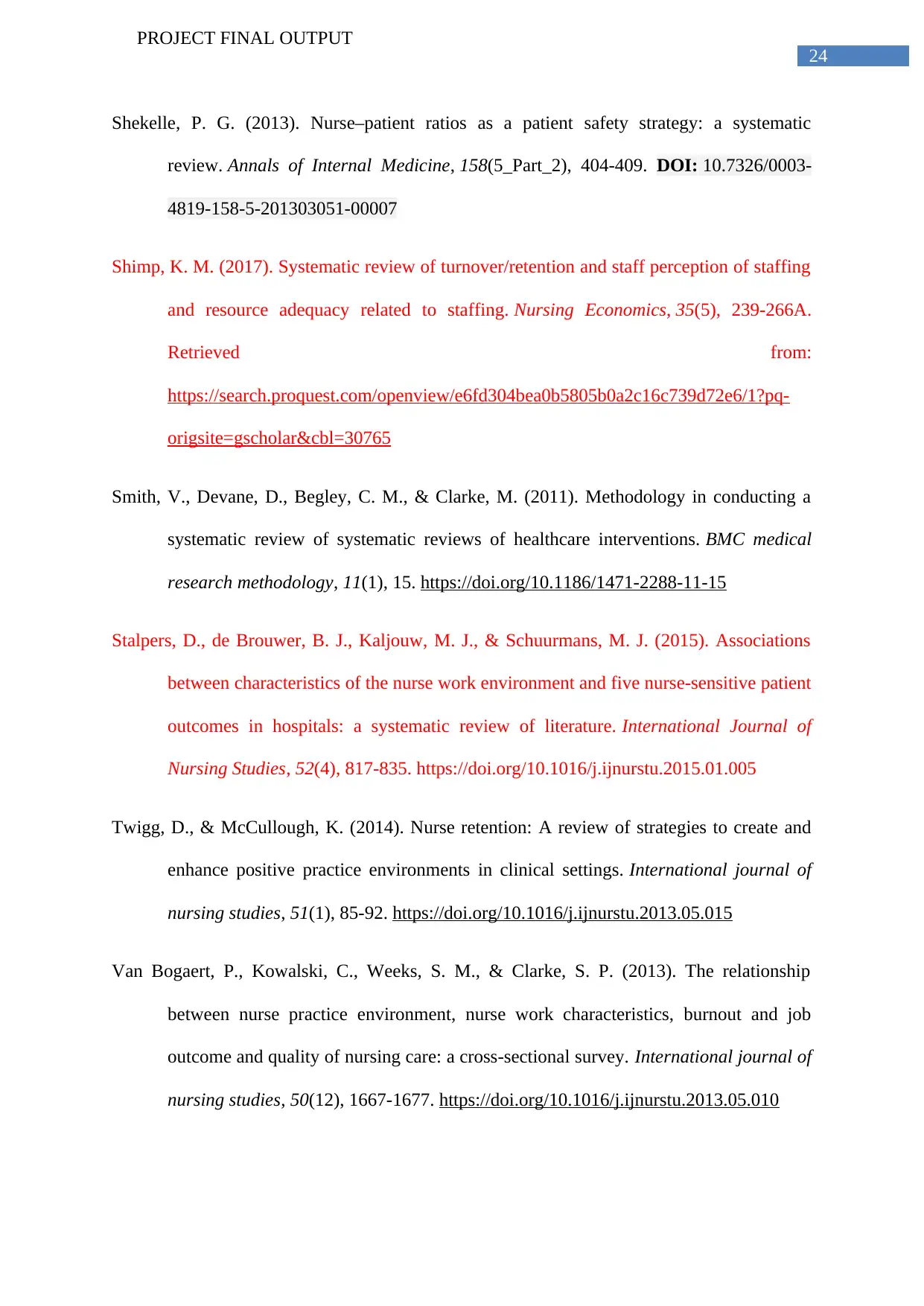
PROJECT FINAL OUTPUT
Shekelle, P. G. (2013). Nurse–patient ratios as a patient safety strategy: a systematic
review. Annals of Internal Medicine, 158(5_Part_2), 404-409. DOI: 10.7326/0003-
4819-158-5-201303051-00007
Shimp, K. M. (2017). Systematic review of turnover/retention and staff perception of staffing
and resource adequacy related to staffing. Nursing Economics, 35(5), 239-266A.
Retrieved from:
https://search.proquest.com/openview/e6fd304bea0b5805b0a2c16c739d72e6/1?pq-
origsite=gscholar&cbl=30765
Smith, V., Devane, D., Begley, C. M., & Clarke, M. (2011). Methodology in conducting a
systematic review of systematic reviews of healthcare interventions. BMC medical
research methodology, 11(1), 15. https://doi.org/10.1186/1471-2288-11-15
Stalpers, D., de Brouwer, B. J., Kaljouw, M. J., & Schuurmans, M. J. (2015). Associations
between characteristics of the nurse work environment and five nurse-sensitive patient
outcomes in hospitals: a systematic review of literature. International Journal of
Nursing Studies, 52(4), 817-835. https://doi.org/10.1016/j.ijnurstu.2015.01.005
Twigg, D., & McCullough, K. (2014). Nurse retention: A review of strategies to create and
enhance positive practice environments in clinical settings. International journal of
nursing studies, 51(1), 85-92. https://doi.org/10.1016/j.ijnurstu.2013.05.015
Van Bogaert, P., Kowalski, C., Weeks, S. M., & Clarke, S. P. (2013). The relationship
between nurse practice environment, nurse work characteristics, burnout and job
outcome and quality of nursing care: a cross-sectional survey. International journal of
nursing studies, 50(12), 1667-1677. https://doi.org/10.1016/j.ijnurstu.2013.05.010
Paraphrase This Document
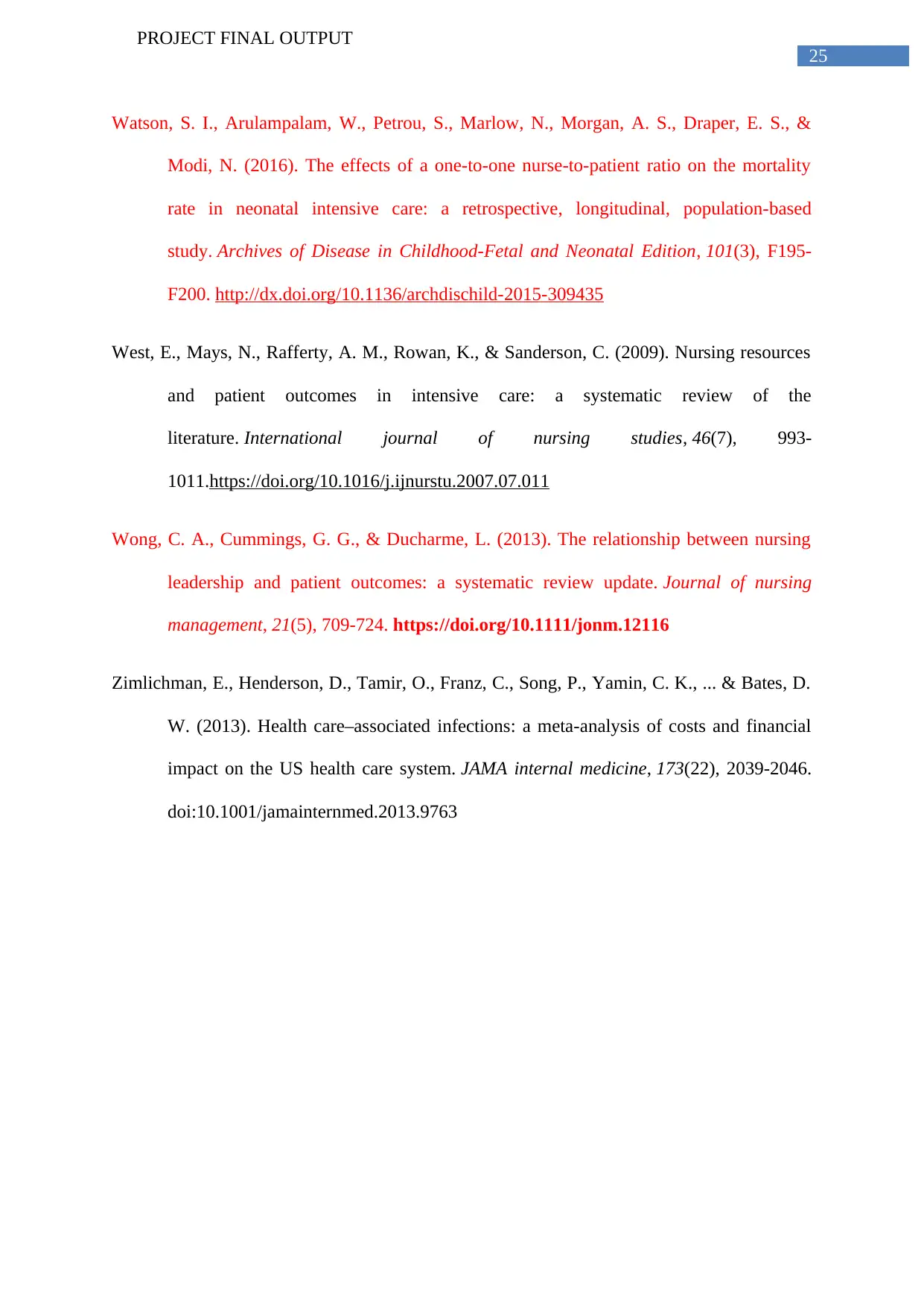
PROJECT FINAL OUTPUT
Watson, S. I., Arulampalam, W., Petrou, S., Marlow, N., Morgan, A. S., Draper, E. S., &
Modi, N. (2016). The effects of a one-to-one nurse-to-patient ratio on the mortality
rate in neonatal intensive care: a retrospective, longitudinal, population-based
study. Archives of Disease in Childhood-Fetal and Neonatal Edition, 101(3), F195-
F200. http://dx.doi.org/10.1136/archdischild-2015-309435
West, E., Mays, N., Rafferty, A. M., Rowan, K., & Sanderson, C. (2009). Nursing resources
and patient outcomes in intensive care: a systematic review of the
literature. International journal of nursing studies, 46(7), 993-
1011.https://doi.org/10.1016/j.ijnurstu.2007.07.011
Wong, C. A., Cummings, G. G., & Ducharme, L. (2013). The relationship between nursing
leadership and patient outcomes: a systematic review update. Journal of nursing
management, 21(5), 709-724. https://doi.org/10.1111/jonm.12116
Zimlichman, E., Henderson, D., Tamir, O., Franz, C., Song, P., Yamin, C. K., ... & Bates, D.
W. (2013). Health care–associated infections: a meta-analysis of costs and financial
impact on the US health care system. JAMA internal medicine, 173(22), 2039-2046.
doi:10.1001/jamainternmed.2013.9763
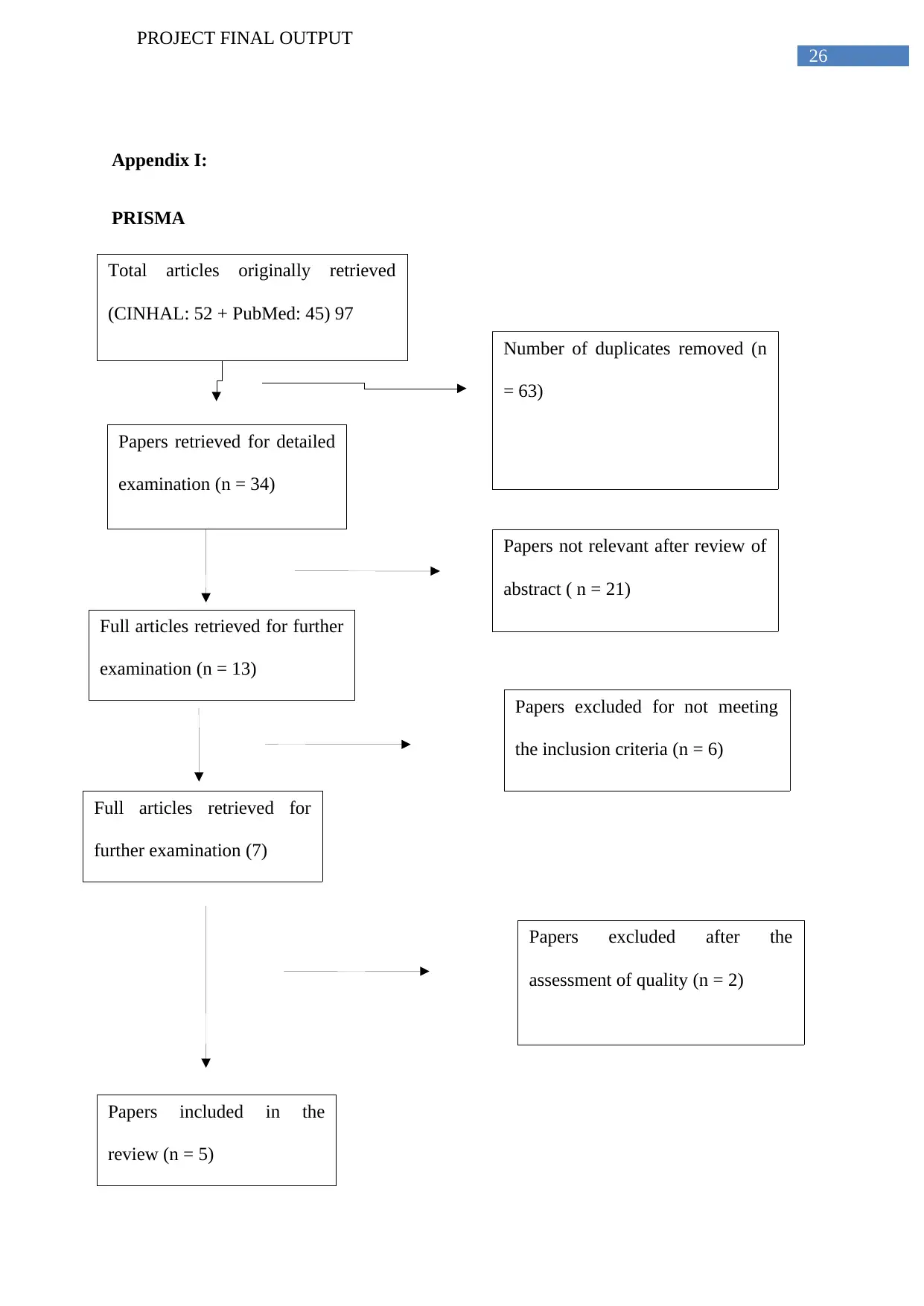
PROJECT FINAL OUTPUT
Appendix I:
PRISMA
Total articles originally retrieved
(CINHAL: 52 + PubMed: 45) 97
Number of duplicates removed (n
= 63)
Full articles retrieved for further
examination (n = 13)
Papers not relevant after review of
abstract ( n = 21)
Papers retrieved for detailed
examination (n = 34)
Full articles retrieved for
further examination (7)
Papers included in the
review (n = 5)
Papers excluded for not meeting
the inclusion criteria (n = 6)
Papers excluded after the
assessment of quality (n = 2)
You're viewing a preview
Unlock full access by subscribing today!

PROJECT FINAL OUTPUT
Appendix 2
CINHAL Search
Keywords used for the search of articles in database pulse use of Boolean operators
(CINHAL)
Keyword 1 nurse patient ratio OR nurse staffing OR patient nurse ratio
Keyword 2 patient safety or patient outcomes or quality of care or safety or error
Keyword 3 job satisfaction or work satisfaction or employee satisfaction
# Query Limiters/Expanders Last run via Results
S1 nurse patient ratio OR
nurse staffing OR patient
nurse ratio
Search modes -
Boolean/Phrase
Interface - EBSCOhost
Research Databases
Search Screen - Advanced
Search
Database - CINAHL
Complete
5,743
S2 ( nurse patient ratio OR
nurse staffing OR patient
nurse ratio ) AND
( patient safety or patient
outcomes or quality of
care or safety or error )
Search modes -
Boolean/Phrase
Interface - EBSCOhost
Research Databases
Search Screen - Advanced
Search
Database - CINAHL
Complete
2,623
S3 ( nurse patient ratio OR
nurse staffing OR patient
nurse ratio ) AND
( patient safety or patient
outcomes or quality of
care or safety or error )
AND ( job satisfaction or
work satisfaction or
employee satisfaction )
Search modes -
Boolean/Phrase
Interface - EBSCOhost
Research Databases
Search Screen - Advanced
Search
Database - CINAHL
Complete
181
Paraphrase This Document
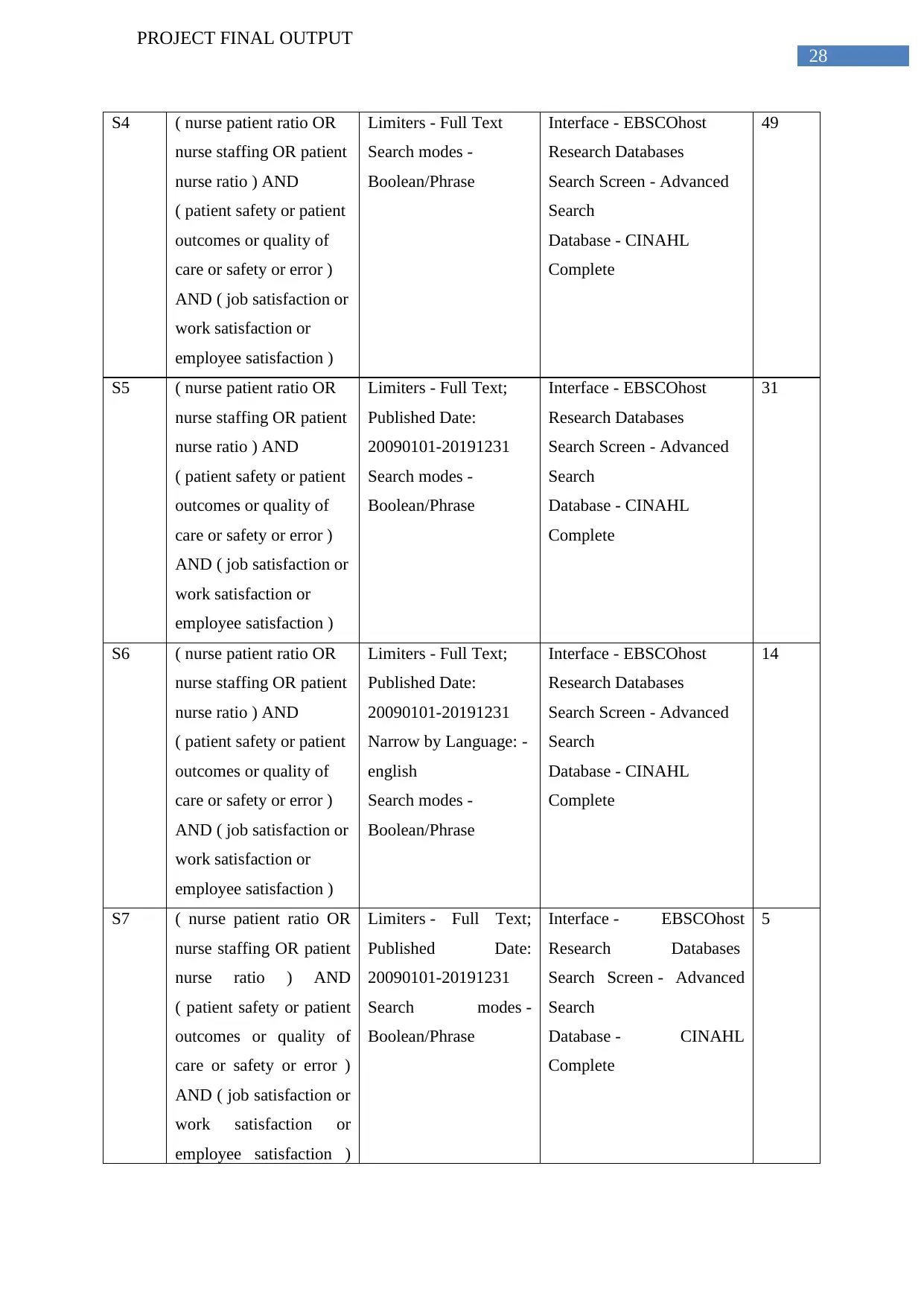
PROJECT FINAL OUTPUT
S4 ( nurse patient ratio OR
nurse staffing OR patient
nurse ratio ) AND
( patient safety or patient
outcomes or quality of
care or safety or error )
AND ( job satisfaction or
work satisfaction or
employee satisfaction )
Limiters - Full Text
Search modes -
Boolean/Phrase
Interface - EBSCOhost
Research Databases
Search Screen - Advanced
Search
Database - CINAHL
Complete
49
S5 ( nurse patient ratio OR
nurse staffing OR patient
nurse ratio ) AND
( patient safety or patient
outcomes or quality of
care or safety or error )
AND ( job satisfaction or
work satisfaction or
employee satisfaction )
Limiters - Full Text;
Published Date:
20090101-20191231
Search modes -
Boolean/Phrase
Interface - EBSCOhost
Research Databases
Search Screen - Advanced
Search
Database - CINAHL
Complete
31
S6 ( nurse patient ratio OR
nurse staffing OR patient
nurse ratio ) AND
( patient safety or patient
outcomes or quality of
care or safety or error )
AND ( job satisfaction or
work satisfaction or
employee satisfaction )
Limiters - Full Text;
Published Date:
20090101-20191231
Narrow by Language: -
english
Search modes -
Boolean/Phrase
Interface - EBSCOhost
Research Databases
Search Screen - Advanced
Search
Database - CINAHL
Complete
14
S7 ( nurse patient ratio OR
nurse staffing OR patient
nurse ratio ) AND
( patient safety or patient
outcomes or quality of
care or safety or error )
AND ( job satisfaction or
work satisfaction or
employee satisfaction )
Limiters - Full Text;
Published Date:
20090101-20191231
Search modes -
Boolean/Phrase
Interface - EBSCOhost
Research Databases
Search Screen - Advanced
Search
Database - CINAHL
Complete
5
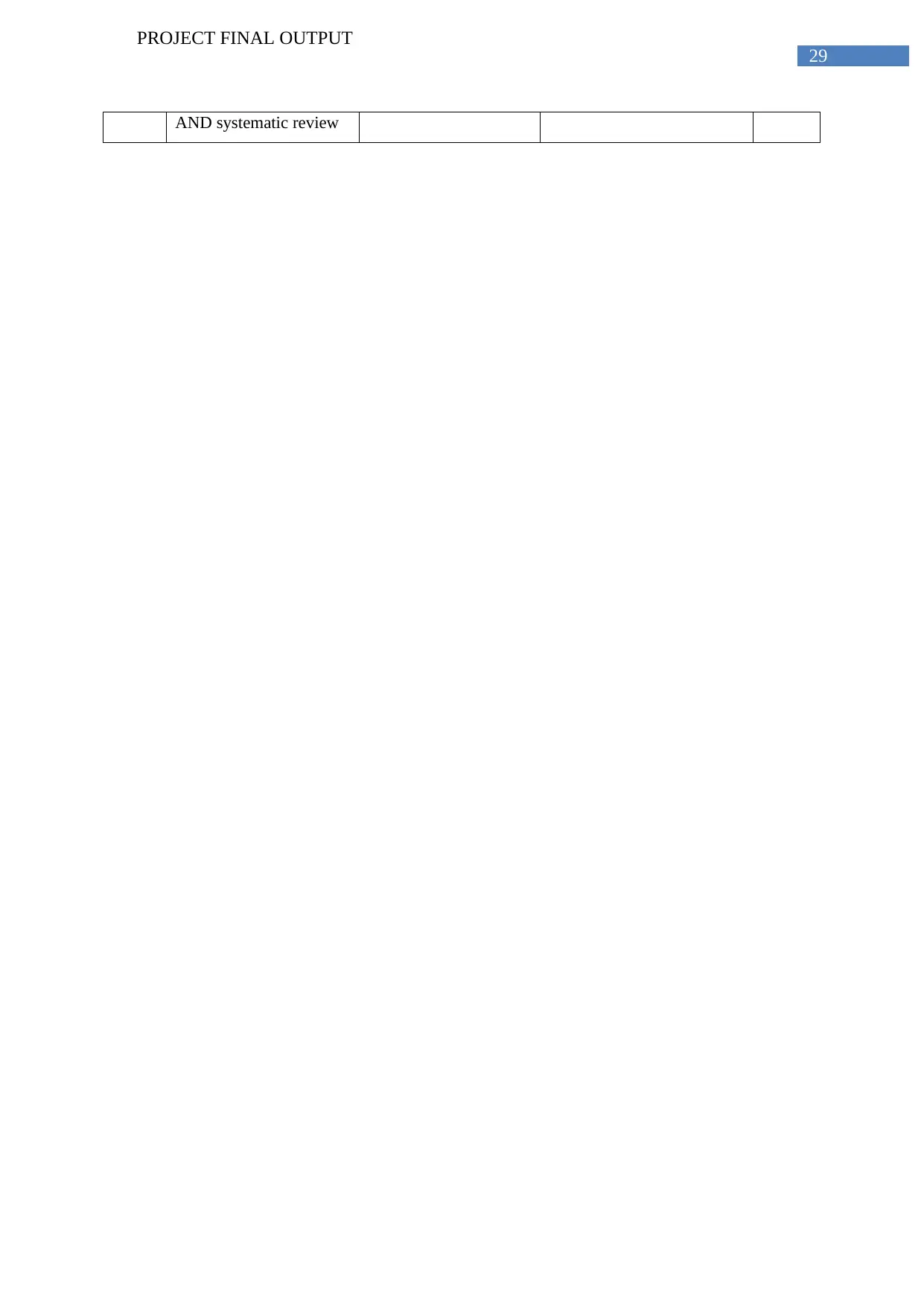
PROJECT FINAL OUTPUT
AND systematic review
You're viewing a preview
Unlock full access by subscribing today!
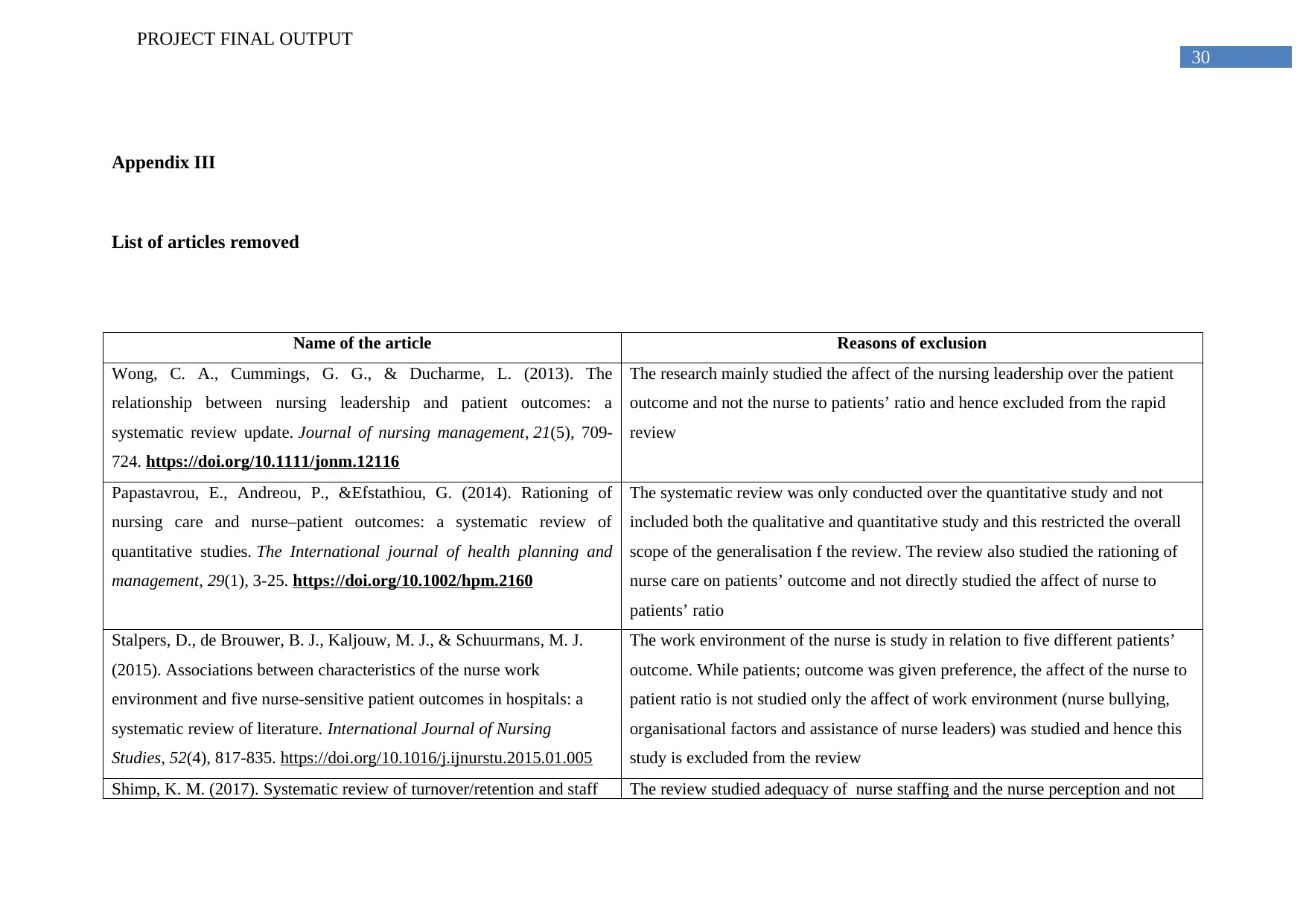
PROJECT FINAL OUTPUT
Appendix III
List of articles removed
Name of the article Reasons of exclusion
Wong, C. A., Cummings, G. G., & Ducharme, L. (2013). The
relationship between nursing leadership and patient outcomes: a
systematic review update. Journal of nursing management, 21(5), 709-
724. https://doi.org/10.1111/jonm.12116
The research mainly studied the affect of the nursing leadership over the patient
outcome and not the nurse to patients’ ratio and hence excluded from the rapid
review
Papastavrou, E., Andreou, P., &Efstathiou, G. (2014). Rationing of
nursing care and nurse–patient outcomes: a systematic review of
quantitative studies. The International journal of health planning and
management, 29(1), 3-25. https://doi.org/10.1002/hpm.2160
The systematic review was only conducted over the quantitative study and not
included both the qualitative and quantitative study and this restricted the overall
scope of the generalisation f the review. The review also studied the rationing of
nurse care on patients’ outcome and not directly studied the affect of nurse to
patients’ ratio
Stalpers, D., de Brouwer, B. J., Kaljouw, M. J., & Schuurmans, M. J.
(2015). Associations between characteristics of the nurse work
environment and five nurse-sensitive patient outcomes in hospitals: a
systematic review of literature. International Journal of Nursing
Studies, 52(4), 817-835. https://doi.org/10.1016/j.ijnurstu.2015.01.005
The work environment of the nurse is study in relation to five different patients’
outcome. While patients; outcome was given preference, the affect of the nurse to
patient ratio is not studied only the affect of work environment (nurse bullying,
organisational factors and assistance of nurse leaders) was studied and hence this
study is excluded from the review
Shimp, K. M. (2017). Systematic review of turnover/retention and staff The review studied adequacy of nurse staffing and the nurse perception and not
Paraphrase This Document
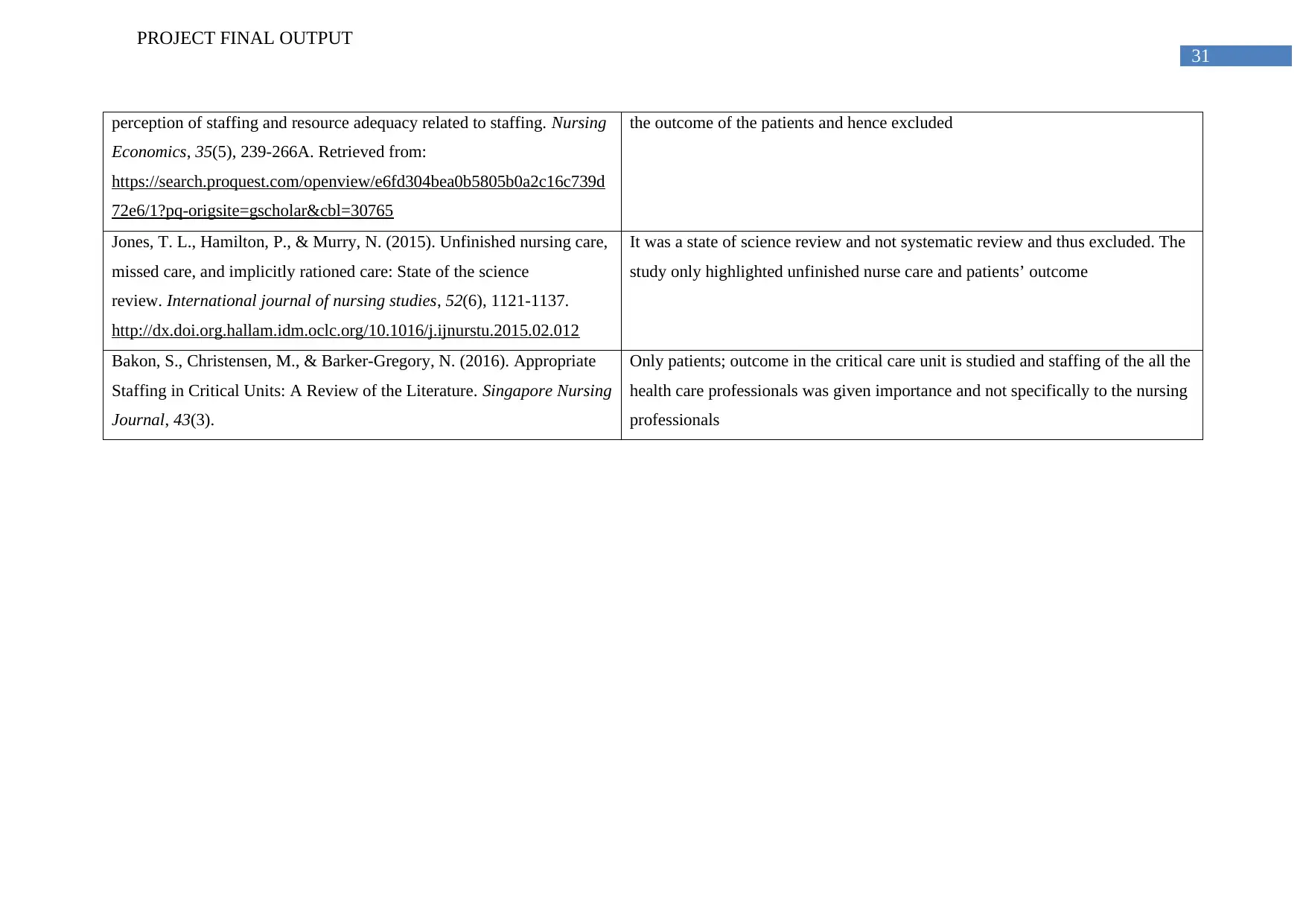
PROJECT FINAL OUTPUT
perception of staffing and resource adequacy related to staffing. Nursing
Economics, 35(5), 239-266A. Retrieved from:
https://search.proquest.com/openview/e6fd304bea0b5805b0a2c16c739d
72e6/1?pq-origsite=gscholar&cbl=30765
the outcome of the patients and hence excluded
Jones, T. L., Hamilton, P., & Murry, N. (2015). Unfinished nursing care,
missed care, and implicitly rationed care: State of the science
review. International journal of nursing studies, 52(6), 1121-1137.
http://dx.doi.org.hallam.idm.oclc.org/10.1016/j.ijnurstu.2015.02.012
It was a state of science review and not systematic review and thus excluded. The
study only highlighted unfinished nurse care and patients’ outcome
Bakon, S., Christensen, M., & Barker-Gregory, N. (2016). Appropriate
Staffing in Critical Units: A Review of the Literature. Singapore Nursing
Journal, 43(3).
Only patients; outcome in the critical care unit is studied and staffing of the all the
health care professionals was given importance and not specifically to the nursing
professionals
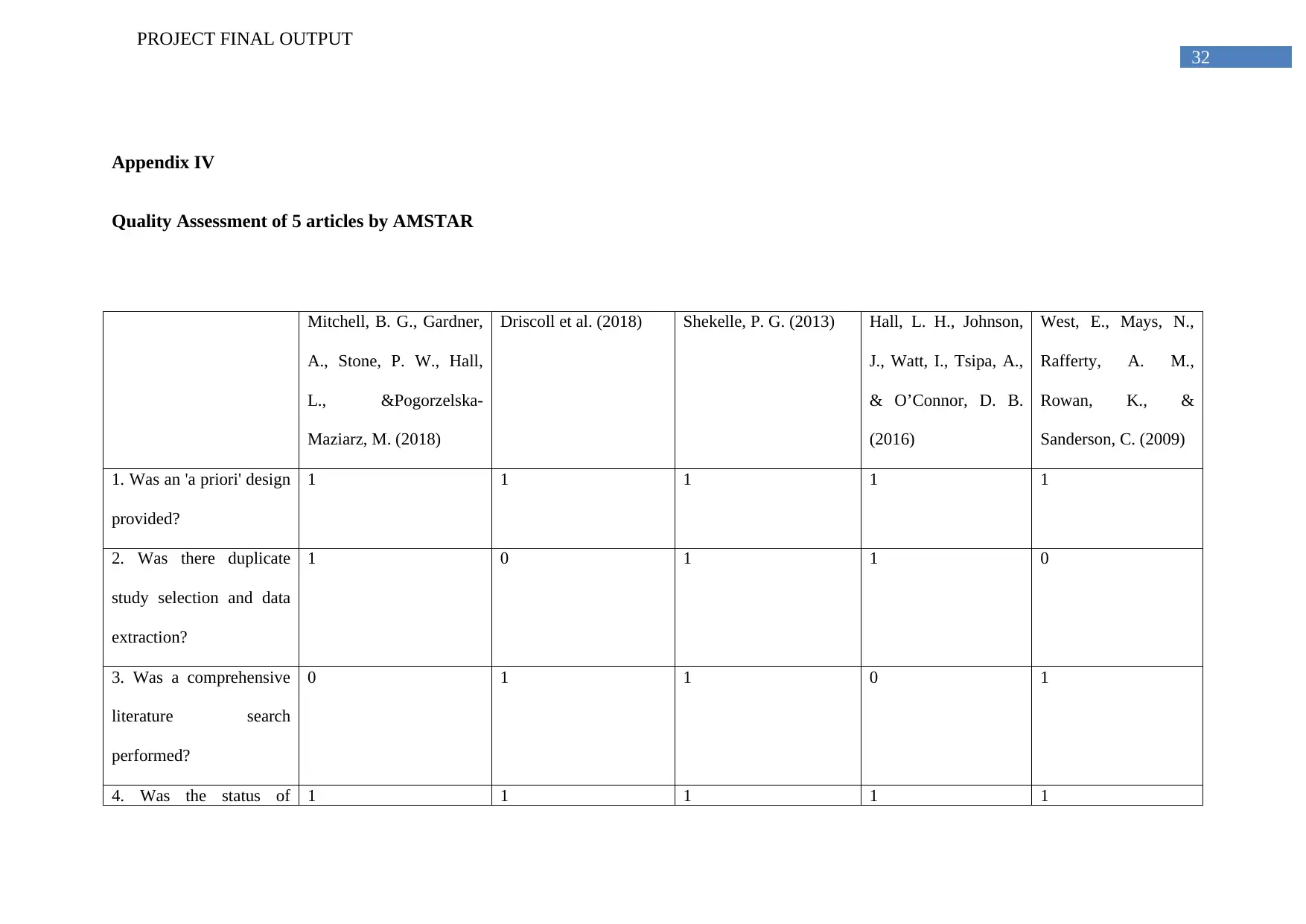
PROJECT FINAL OUTPUT
Appendix IV
Quality Assessment of 5 articles by AMSTAR
Mitchell, B. G., Gardner,
A., Stone, P. W., Hall,
L., &Pogorzelska-
Maziarz, M. (2018)
Driscoll et al. (2018) Shekelle, P. G. (2013) Hall, L. H., Johnson,
J., Watt, I., Tsipa, A.,
& O’Connor, D. B.
(2016)
West, E., Mays, N.,
Rafferty, A. M.,
Rowan, K., &
Sanderson, C. (2009)
1. Was an 'a priori' design
provided?
1 1 1 1 1
2. Was there duplicate
study selection and data
extraction?
1 0 1 1 0
3. Was a comprehensive
literature search
performed?
0 1 1 0 1
4. Was the status of 1 1 1 1 1
You're viewing a preview
Unlock full access by subscribing today!
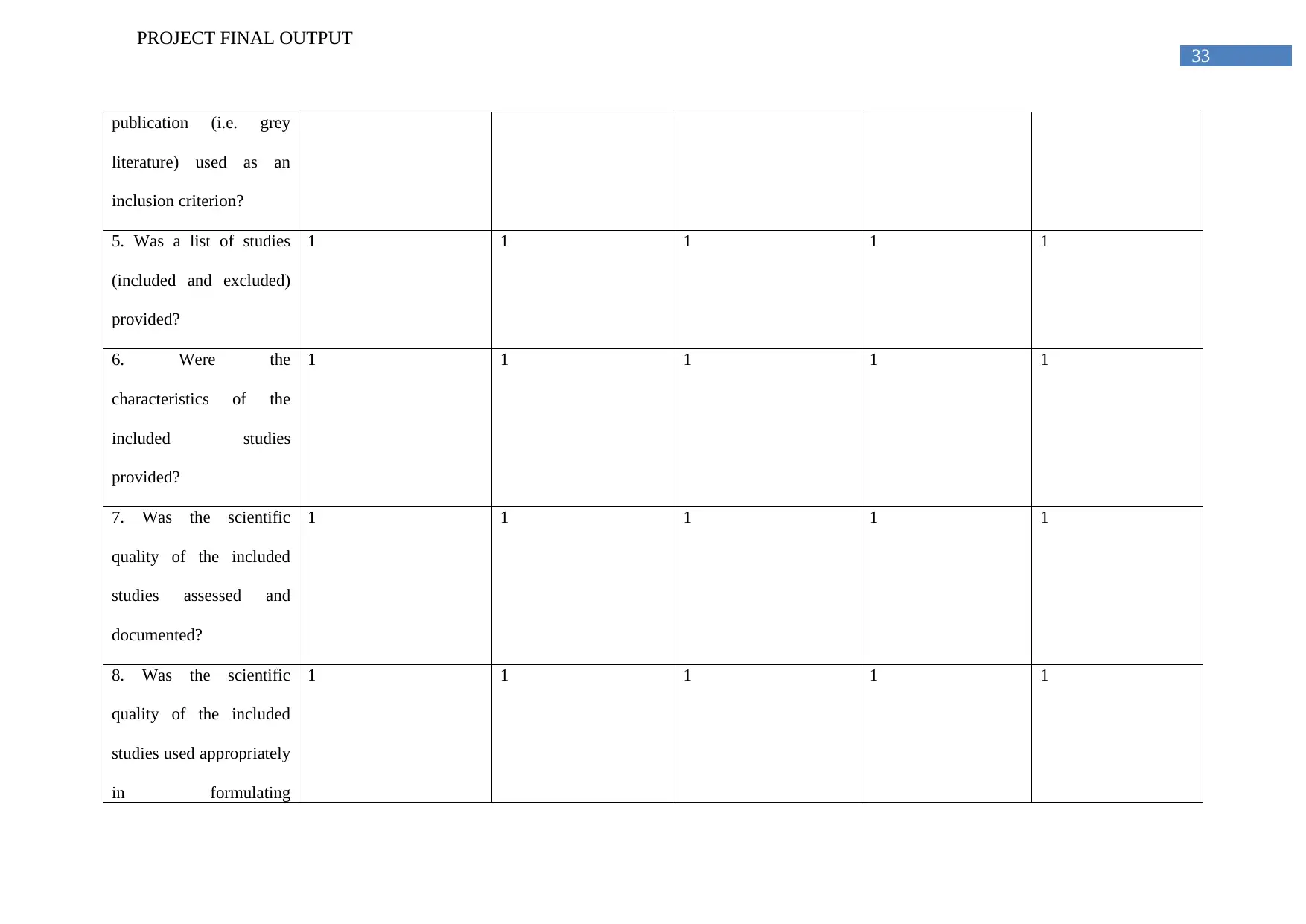
PROJECT FINAL OUTPUT
publication (i.e. grey
literature) used as an
inclusion criterion?
5. Was a list of studies
(included and excluded)
provided?
1 1 1 1 1
6. Were the
characteristics of the
included studies
provided?
1 1 1 1 1
7. Was the scientific
quality of the included
studies assessed and
documented?
1 1 1 1 1
8. Was the scientific
quality of the included
studies used appropriately
in formulating
1 1 1 1 1
Paraphrase This Document
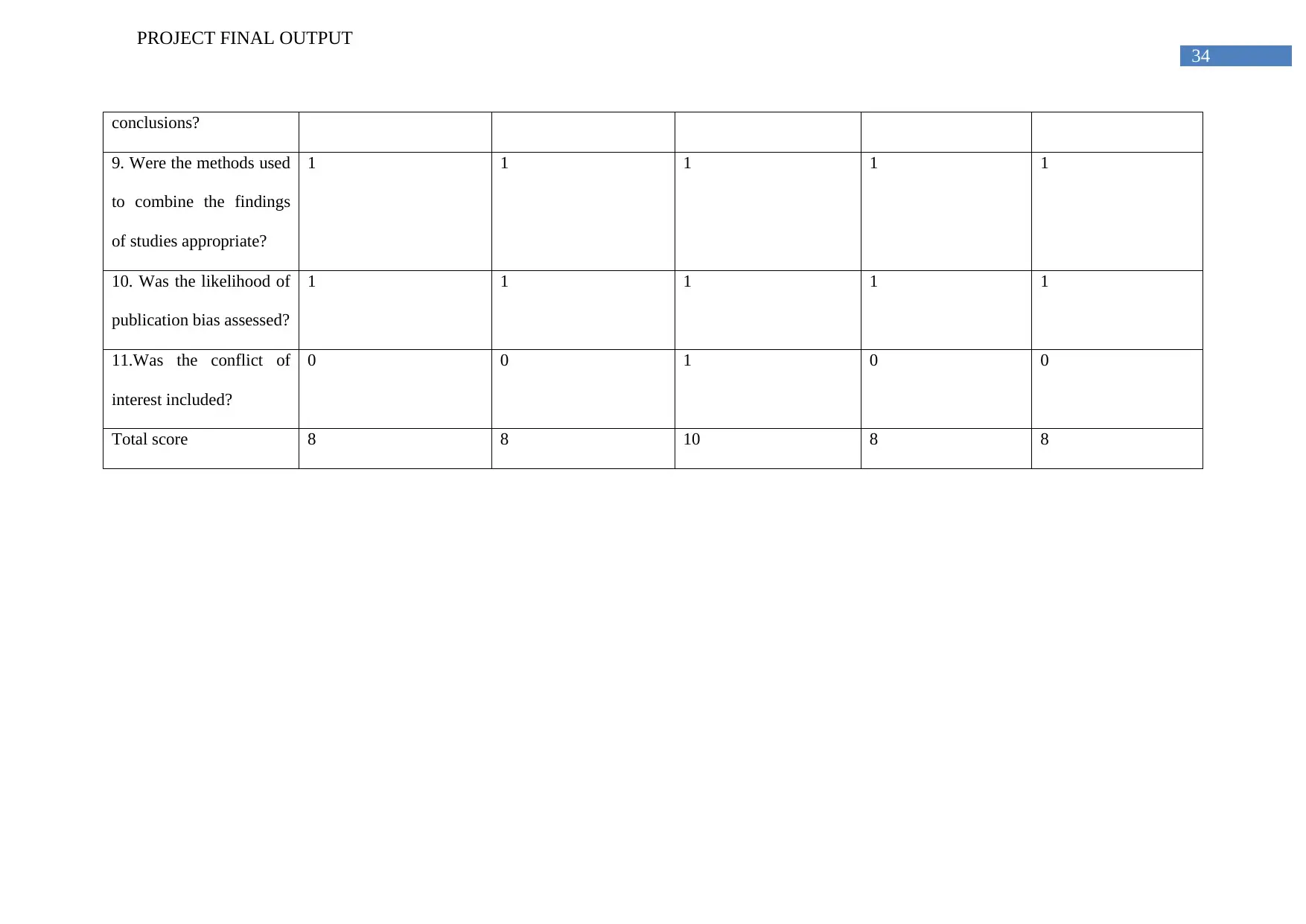
PROJECT FINAL OUTPUT
conclusions?
9. Were the methods used
to combine the findings
of studies appropriate?
1 1 1 1 1
10. Was the likelihood of
publication bias assessed?
1 1 1 1 1
11.Was the conflict of
interest included?
0 0 1 0 0
Total score 8 8 10 8 8

PROJECT FINAL OUTPUT
Appendix V
Annotated bibliography of the reviews
Paper Aim Specific
interventions
Results Conclusion Positive outcomes Negative outcomes
1 Mitchell, B. G.,
Gardner, A.,
Stone, P. W.,
Hall, L.,
&Pogorzelska-
Maziarz, M.
(2018)
To understand and
synthesize the most
recent research on the
relationship of
hospitalstaffingandHAIri
sk.
Increase in
hospital
staffing
Fifty-four
articles were
included in the
review.The
majority of
studies
examined the
relationship
between nurse
staffingandHAI
s(n=50,92.6%)a
Despite the lack of
consistency of the
included studies,
overall, the results of
this systematic
review demonstrate
that increased staffing
is related to
decreased risk of
acquiring HAIs.
More rigorous and
Increase in the
staffing help to
reduce HAIs and
helping to reduce
patents risk
Increase in the overall
cost of care
You're viewing a preview
Unlock full access by subscribing today!
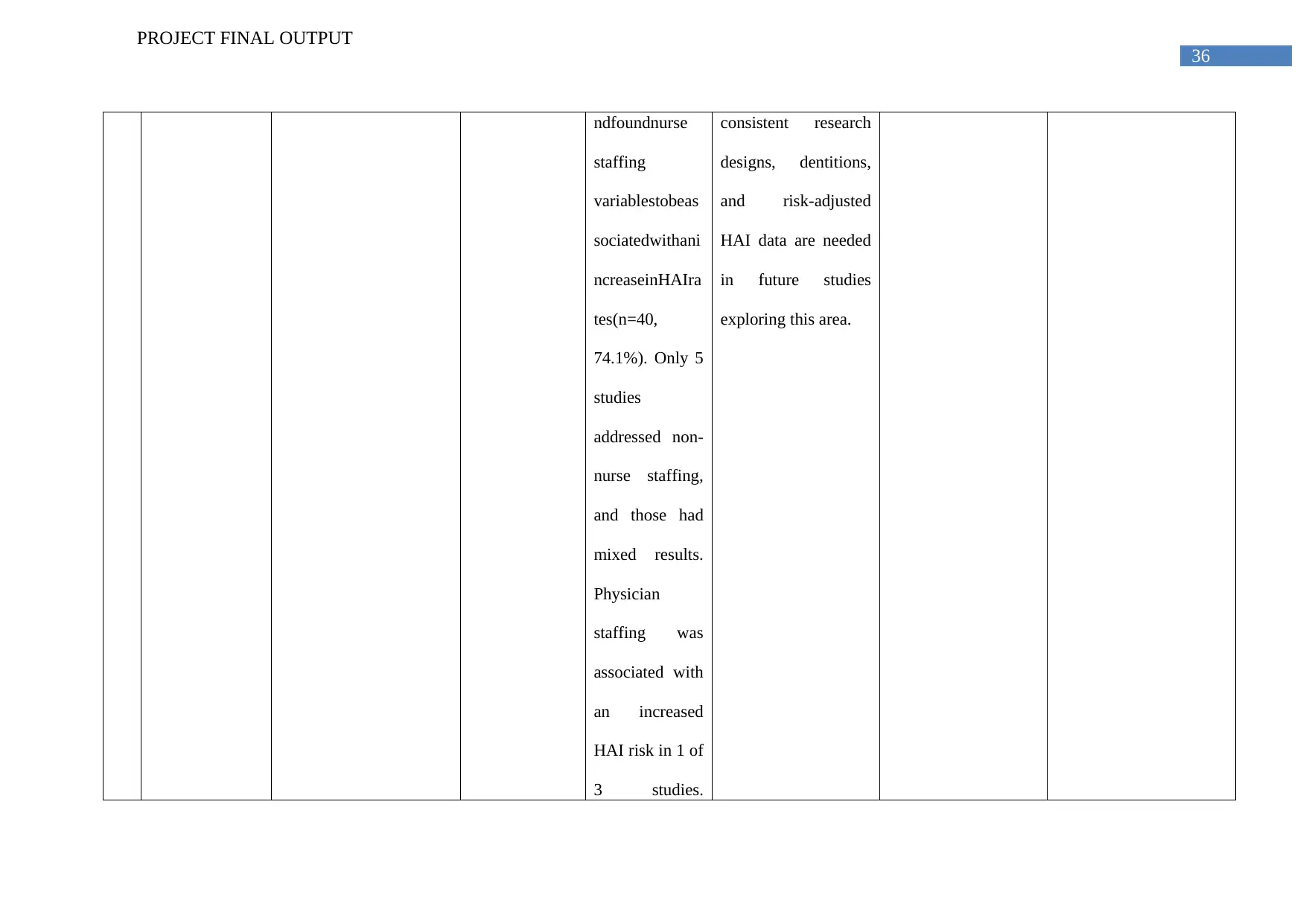
PROJECT FINAL OUTPUT
ndfoundnurse
staffing
variablestobeas
sociatedwithani
ncreaseinHAIra
tes(n=40,
74.1%). Only 5
studies
addressed non-
nurse staffing,
and those had
mixed results.
Physician
staffing was
associated with
an increased
HAI risk in 1 of
3 studies.
consistent research
designs, dentitions,
and risk-adjusted
HAI data are needed
in future studies
exploring this area.
Paraphrase This Document
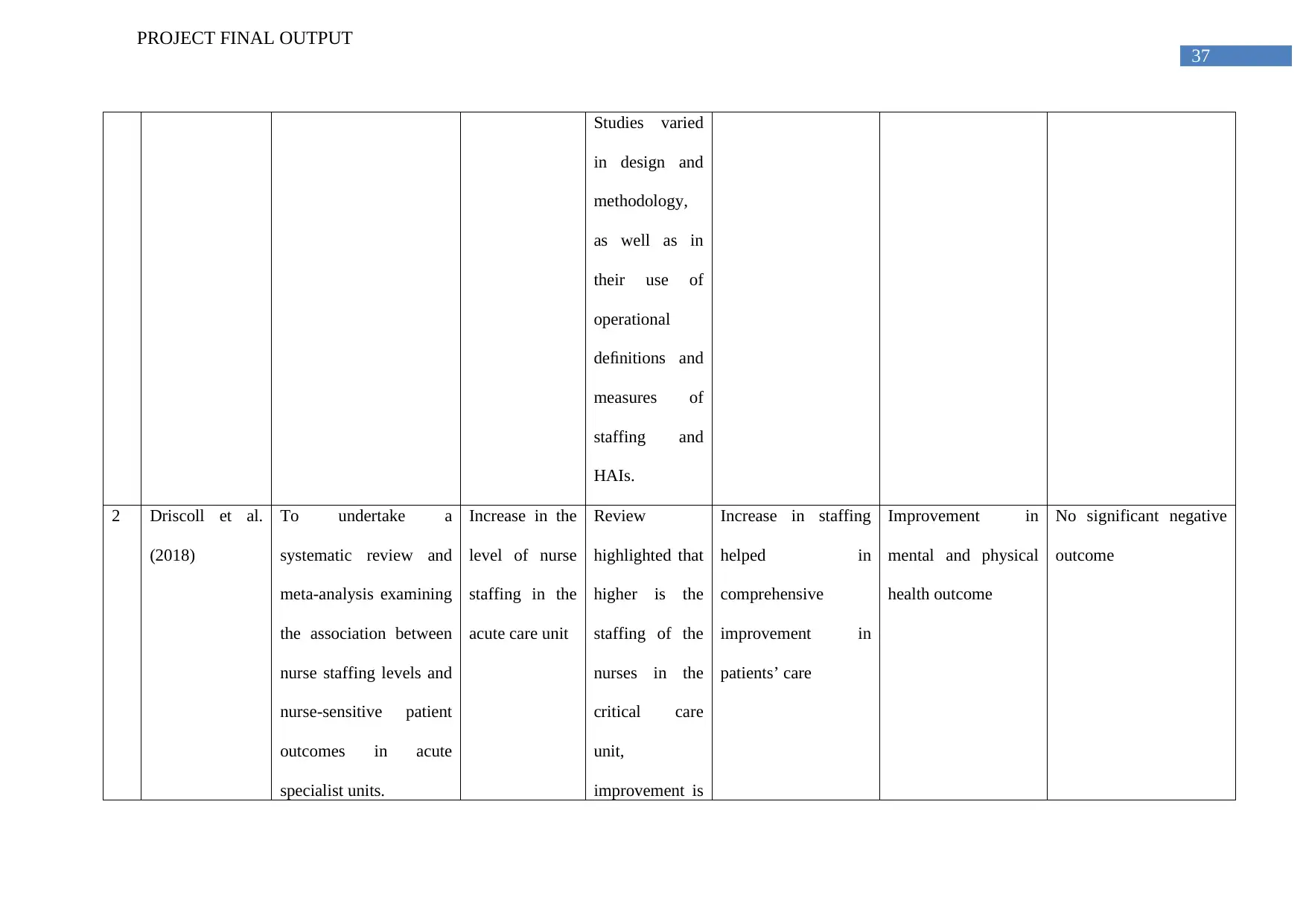
PROJECT FINAL OUTPUT
Studies varied
in design and
methodology,
as well as in
their use of
operational
definitions and
measures of
staffing and
HAIs.
2 Driscoll et al.
(2018)
To undertake a
systematic review and
meta-analysis examining
the association between
nurse staffing levels and
nurse-sensitive patient
outcomes in acute
specialist units.
Increase in the
level of nurse
staffing in the
acute care unit
Review
highlighted that
higher is the
staffing of the
nurses in the
critical care
unit,
improvement is
Increase in staffing
helped in
comprehensive
improvement in
patients’ care
Improvement in
mental and physical
health outcome
No significant negative
outcome
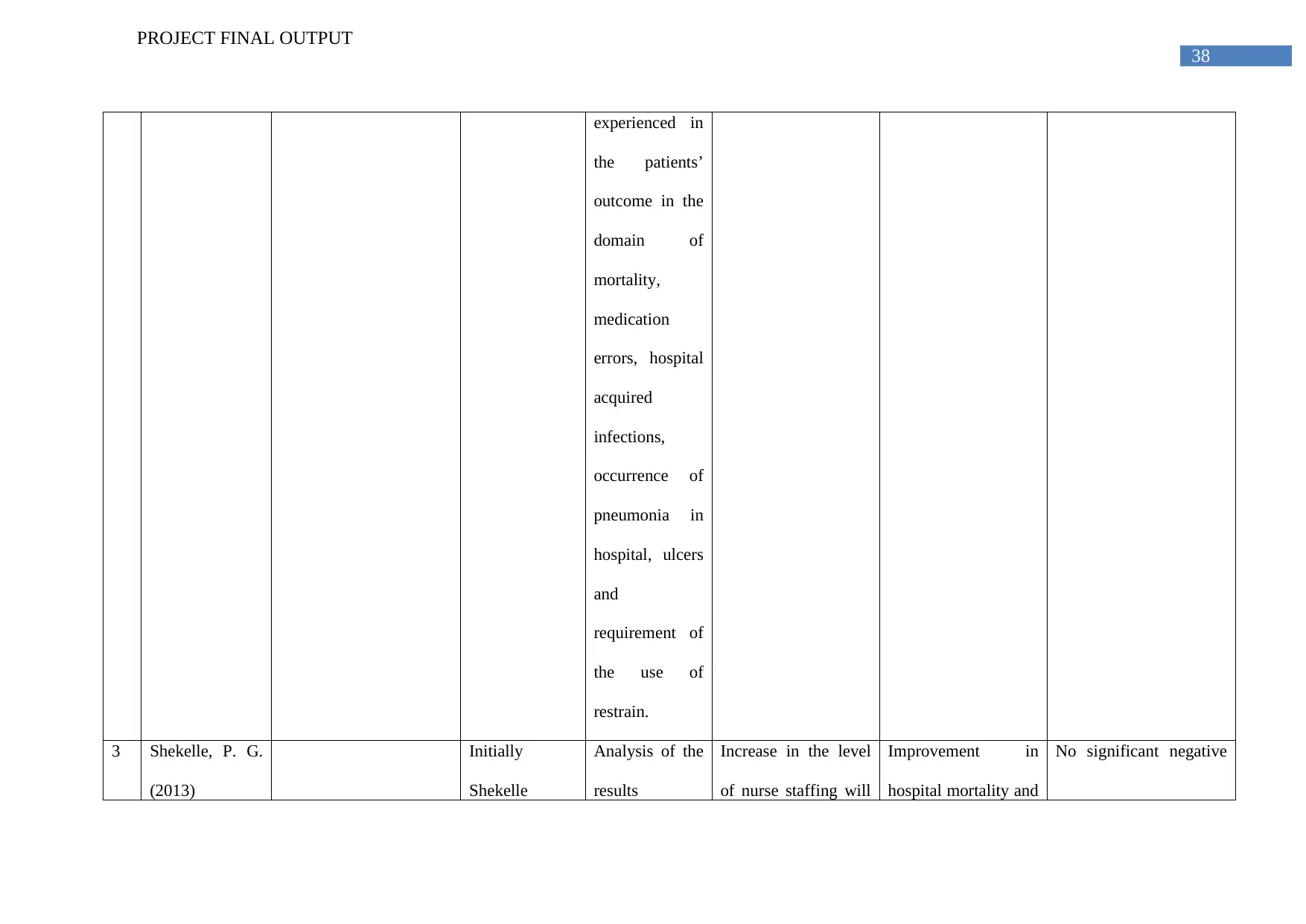
PROJECT FINAL OUTPUT
experienced in
the patients’
outcome in the
domain of
mortality,
medication
errors, hospital
acquired
infections,
occurrence of
pneumonia in
hospital, ulcers
and
requirement of
the use of
restrain.
3 Shekelle, P. G.
(2013)
Initially
Shekelle
Analysis of the
results
Increase in the level
of nurse staffing will
Improvement in
hospital mortality and
No significant negative
You're viewing a preview
Unlock full access by subscribing today!
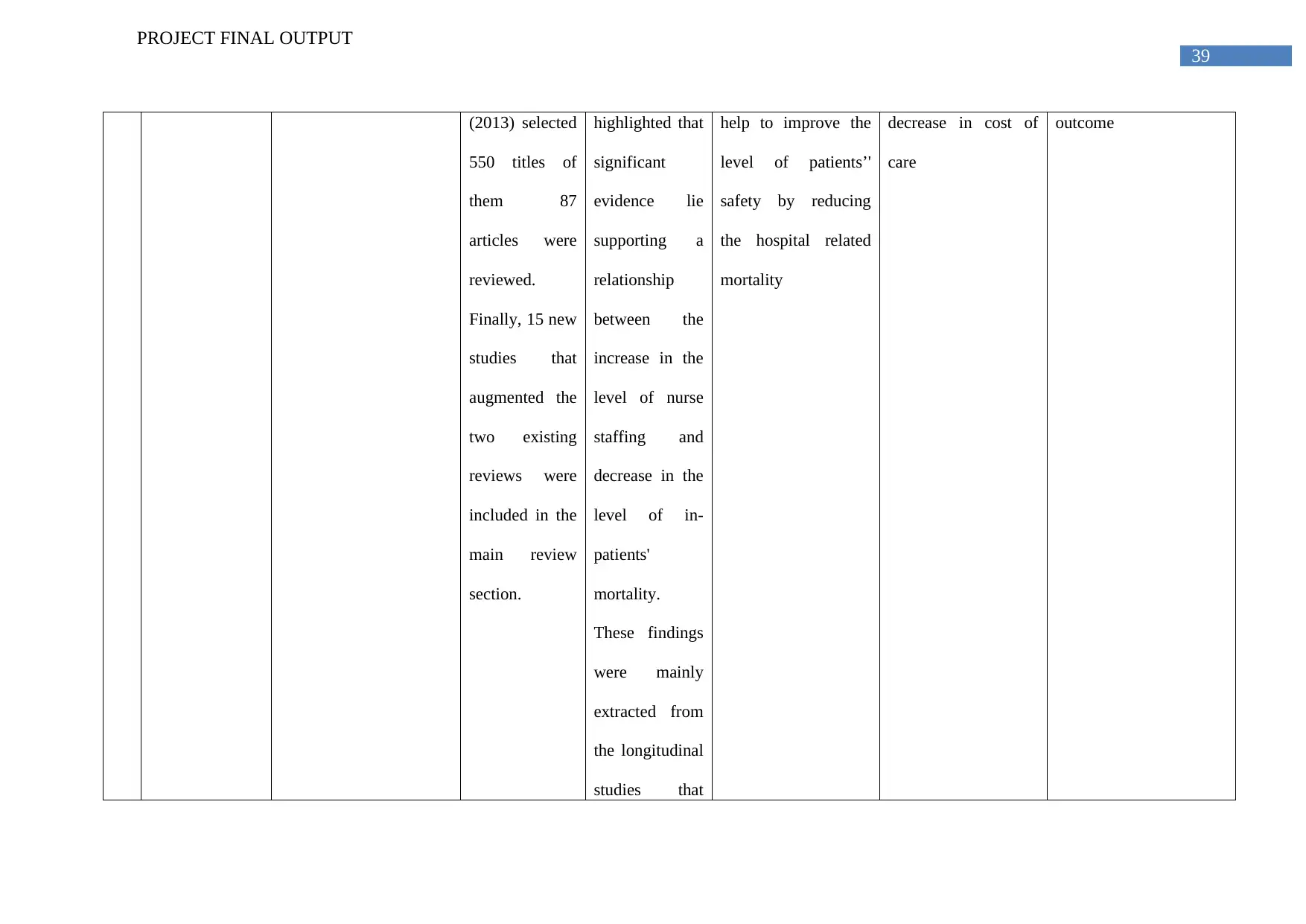
PROJECT FINAL OUTPUT
(2013) selected
550 titles of
them 87
articles were
reviewed.
Finally, 15 new
studies that
augmented the
two existing
reviews were
included in the
main review
section.
highlighted that
significant
evidence lie
supporting a
relationship
between the
increase in the
level of nurse
staffing and
decrease in the
level of in-
patients'
mortality.
These findings
were mainly
extracted from
the longitudinal
studies that
help to improve the
level of patients’'
safety by reducing
the hospital related
mortality
decrease in cost of
care
outcome
Paraphrase This Document
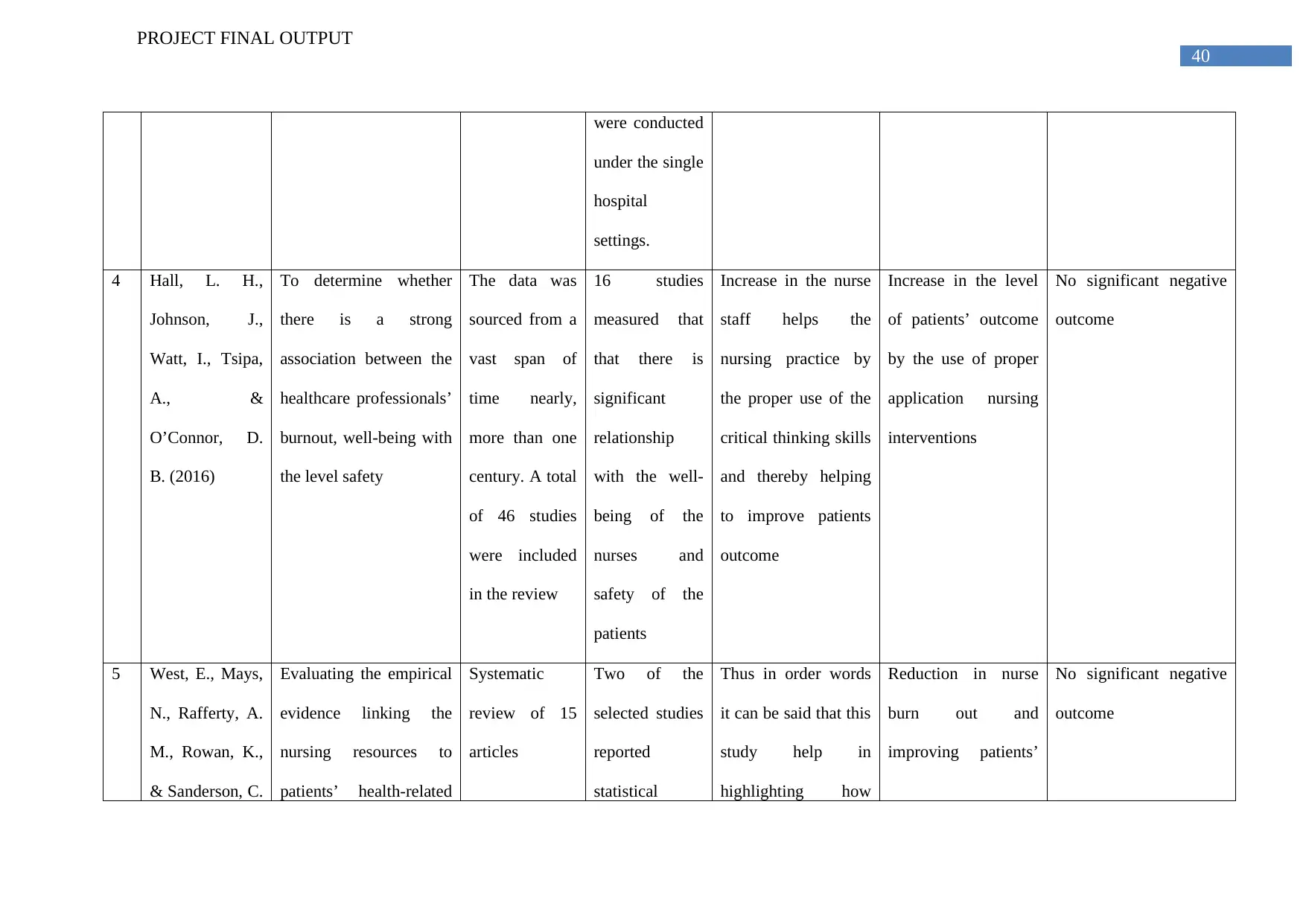
PROJECT FINAL OUTPUT
were conducted
under the single
hospital
settings.
4 Hall, L. H.,
Johnson, J.,
Watt, I., Tsipa,
A., &
O’Connor, D.
B. (2016)
To determine whether
there is a strong
association between the
healthcare professionals’
burnout, well-being with
the level safety
The data was
sourced from a
vast span of
time nearly,
more than one
century. A total
of 46 studies
were included
in the review
16 studies
measured that
that there is
significant
relationship
with the well-
being of the
nurses and
safety of the
patients
Increase in the nurse
staff helps the
nursing practice by
the proper use of the
critical thinking skills
and thereby helping
to improve patients
outcome
Increase in the level
of patients’ outcome
by the use of proper
application nursing
interventions
No significant negative
outcome
5 West, E., Mays,
N., Rafferty, A.
M., Rowan, K.,
& Sanderson, C.
Evaluating the empirical
evidence linking the
nursing resources to
patients’ health-related
Systematic
review of 15
articles
Two of the
selected studies
reported
statistical
Thus in order words
it can be said that this
study help in
highlighting how
Reduction in nurse
burn out and
improving patients’
No significant negative
outcome
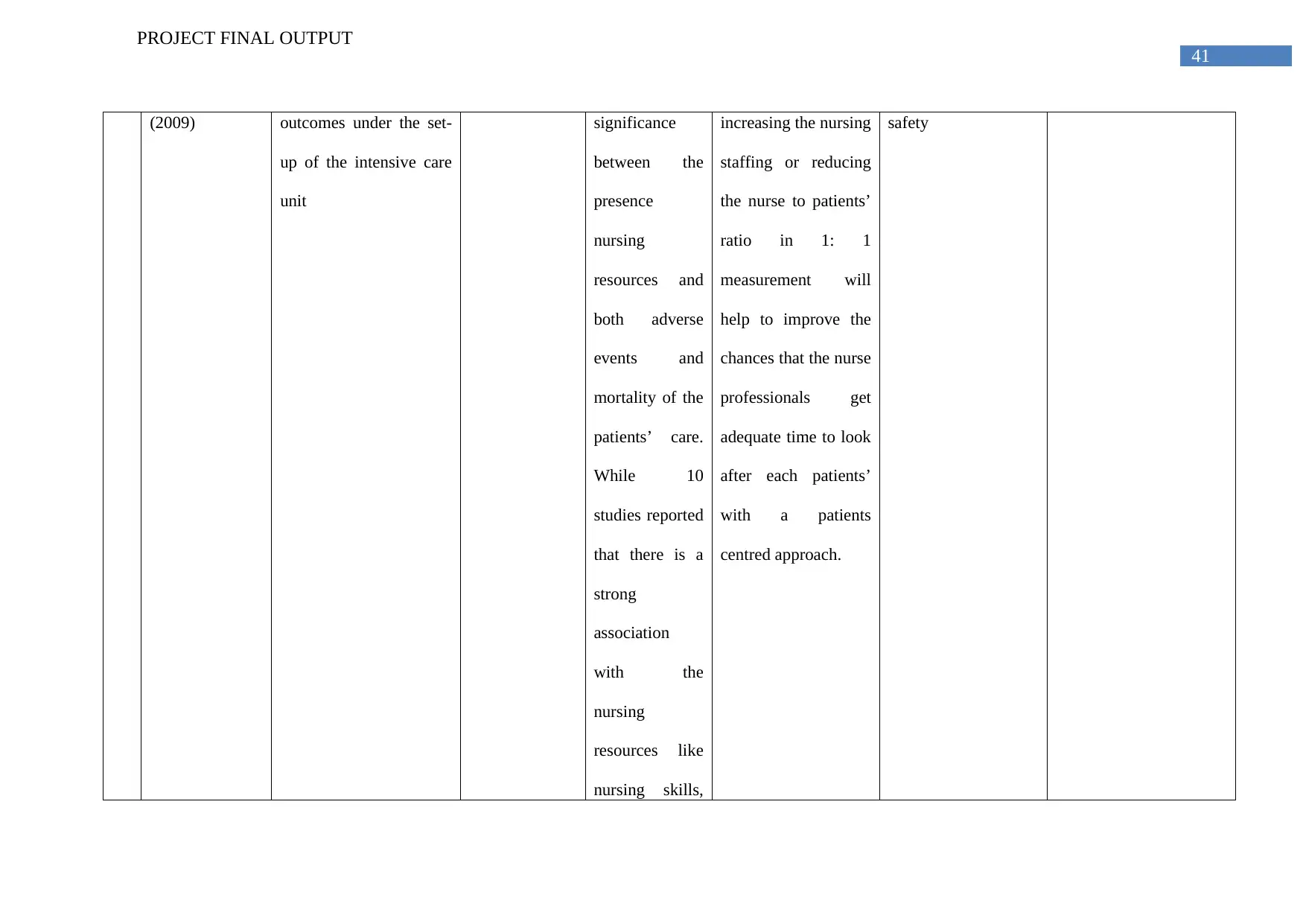
PROJECT FINAL OUTPUT
(2009) outcomes under the set-
up of the intensive care
unit
significance
between the
presence
nursing
resources and
both adverse
events and
mortality of the
patients’ care.
While 10
studies reported
that there is a
strong
association
with the
nursing
resources like
nursing skills,
increasing the nursing
staffing or reducing
the nurse to patients’
ratio in 1: 1
measurement will
help to improve the
chances that the nurse
professionals get
adequate time to look
after each patients’
with a patients
centred approach.
safety
You're viewing a preview
Unlock full access by subscribing today!
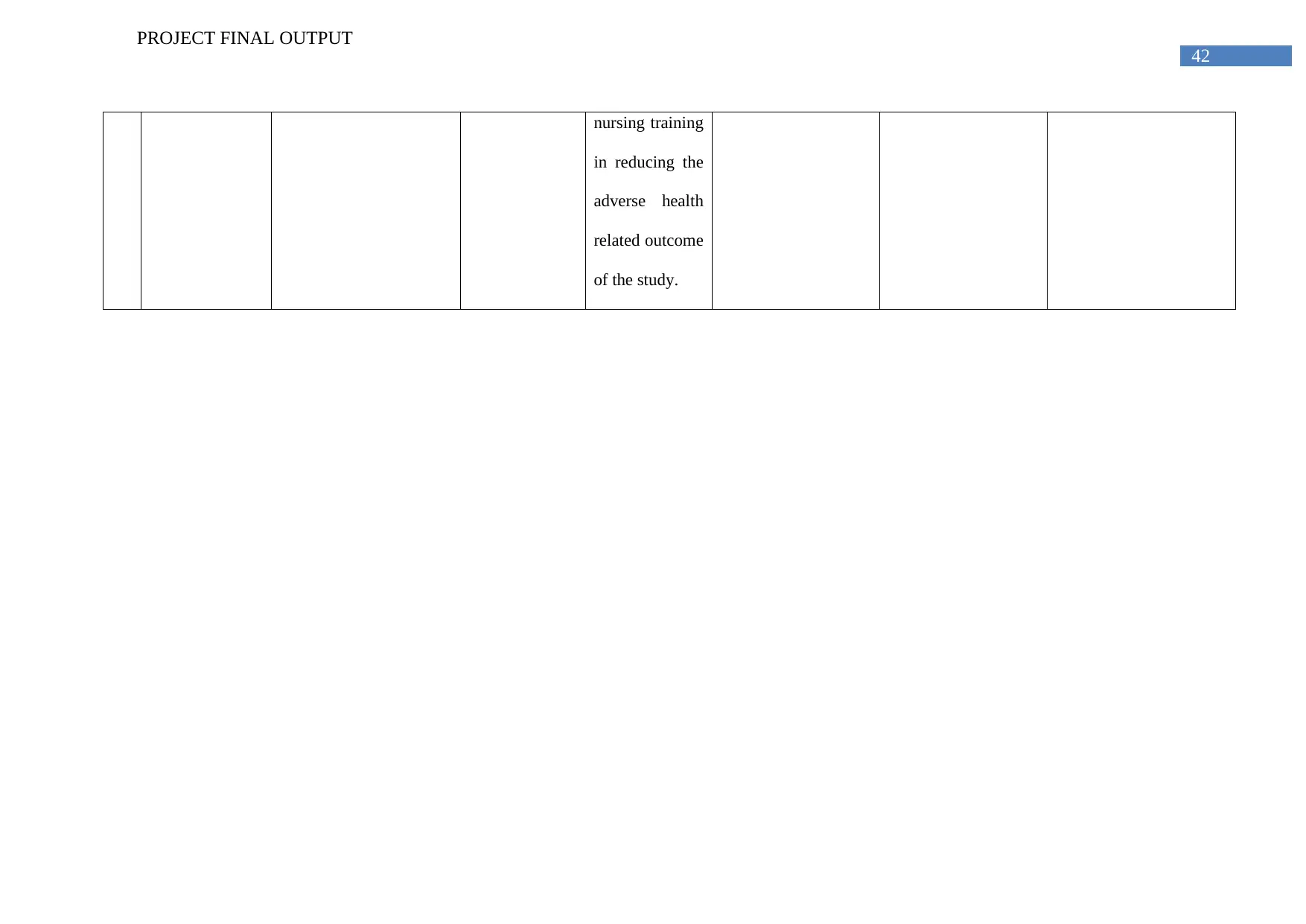
PROJECT FINAL OUTPUT
nursing training
in reducing the
adverse health
related outcome
of the study.
Paraphrase This Document

PROJECT FINAL OUTPUT
Appendix VI
Findings of the review
Intervention Positive outcomes Negative outcomes Unclear outcomes
Mitchell, B. G., Gardner, A.,
Stone, P. W., Hall, L., &
Pogorzelska-Maziarz, M.
(2018)
Increase in the nurse staffing
in accordance to the strength
of the patients admitted in
the intensive care units
Increase in the nurse staffing
helps to reduce the chances
of occurrence of the hospital
acquired infection like blood
stream infection, ventilator
associated pneumonia and
urinary tract infection
The review failed to
highlight how nurse staffing
helps to reduce the chance of
the surgical site infection or
wound infection
The paper failed to highlight
whether only the staffing of
the nurses or increase in the
staffing of nurses along with
the allied healthcare
professional help to reduce
the chances of the hospital
acquired infection
Driscoll, A., Grant, M. J.,
Carroll, D., Dalton, S.,
Deaton, C., Jones, I., ... &
Astin, F. (2018)
Increase in the nurse staffing
levels and its impact on the
nurse-sensitive patients’
outcome
Increase in the ratio of the
nurses as per the strength of
the patients helps to reduce
the mortality rate of the
patients under hospital
In acute care unit increase in
nurse staffing as per the
patient’ strength leads to
over-crowding and hamper in
free working activity of the
Only one patients outcome
showed significant
relationship (patients
mortality). The systematic
review failed to reveal other
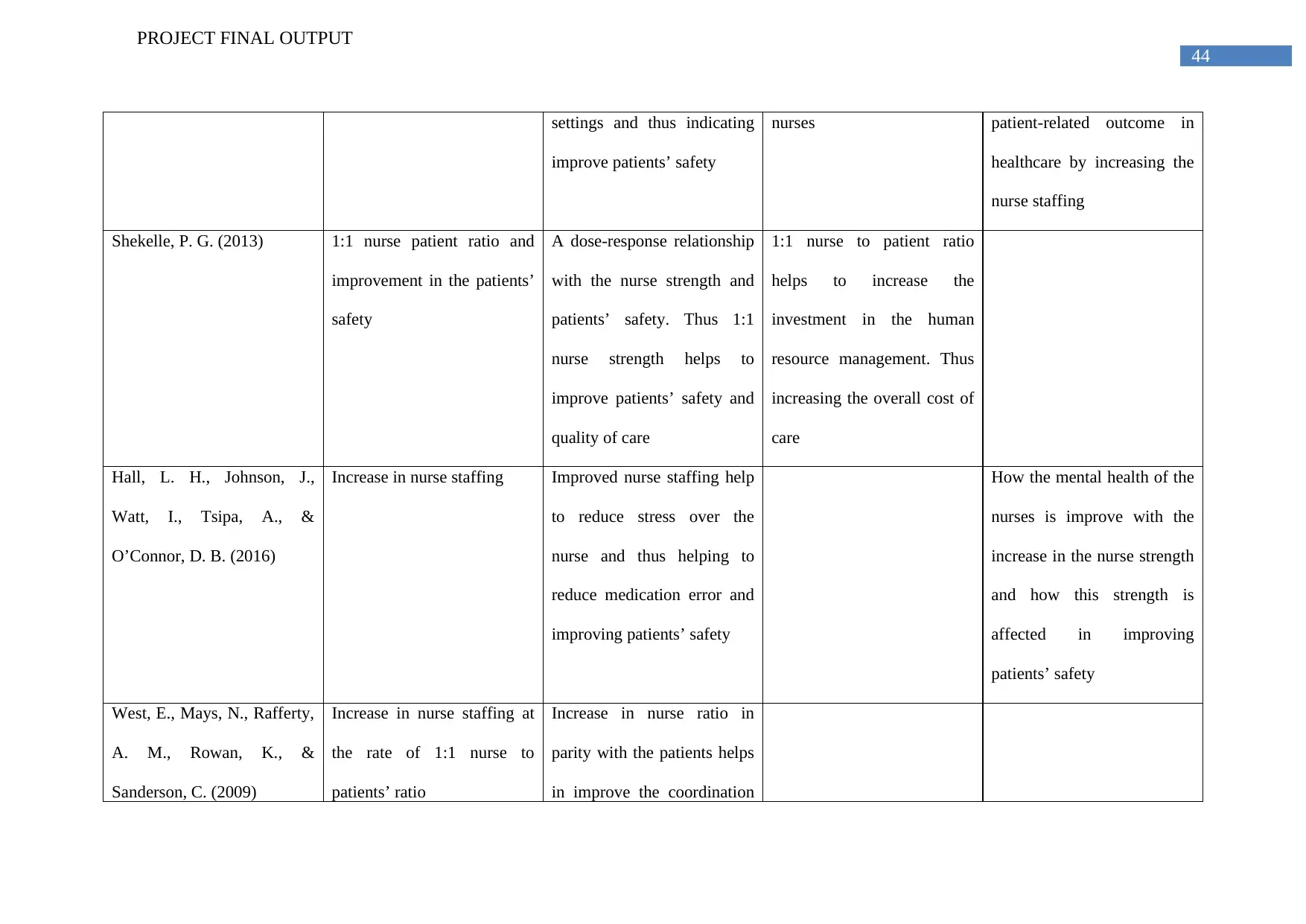
PROJECT FINAL OUTPUT
settings and thus indicating
improve patients’ safety
nurses patient-related outcome in
healthcare by increasing the
nurse staffing
Shekelle, P. G. (2013) 1:1 nurse patient ratio and
improvement in the patients’
safety
A dose-response relationship
with the nurse strength and
patients’ safety. Thus 1:1
nurse strength helps to
improve patients’ safety and
quality of care
1:1 nurse to patient ratio
helps to increase the
investment in the human
resource management. Thus
increasing the overall cost of
care
Hall, L. H., Johnson, J.,
Watt, I., Tsipa, A., &
O’Connor, D. B. (2016)
Increase in nurse staffing Improved nurse staffing help
to reduce stress over the
nurse and thus helping to
reduce medication error and
improving patients’ safety
How the mental health of the
nurses is improve with the
increase in the nurse strength
and how this strength is
affected in improving
patients’ safety
West, E., Mays, N., Rafferty,
A. M., Rowan, K., &
Sanderson, C. (2009)
Increase in nurse staffing at
the rate of 1:1 nurse to
patients’ ratio
Increase in nurse ratio in
parity with the patients helps
in improve the coordination
You're viewing a preview
Unlock full access by subscribing today!
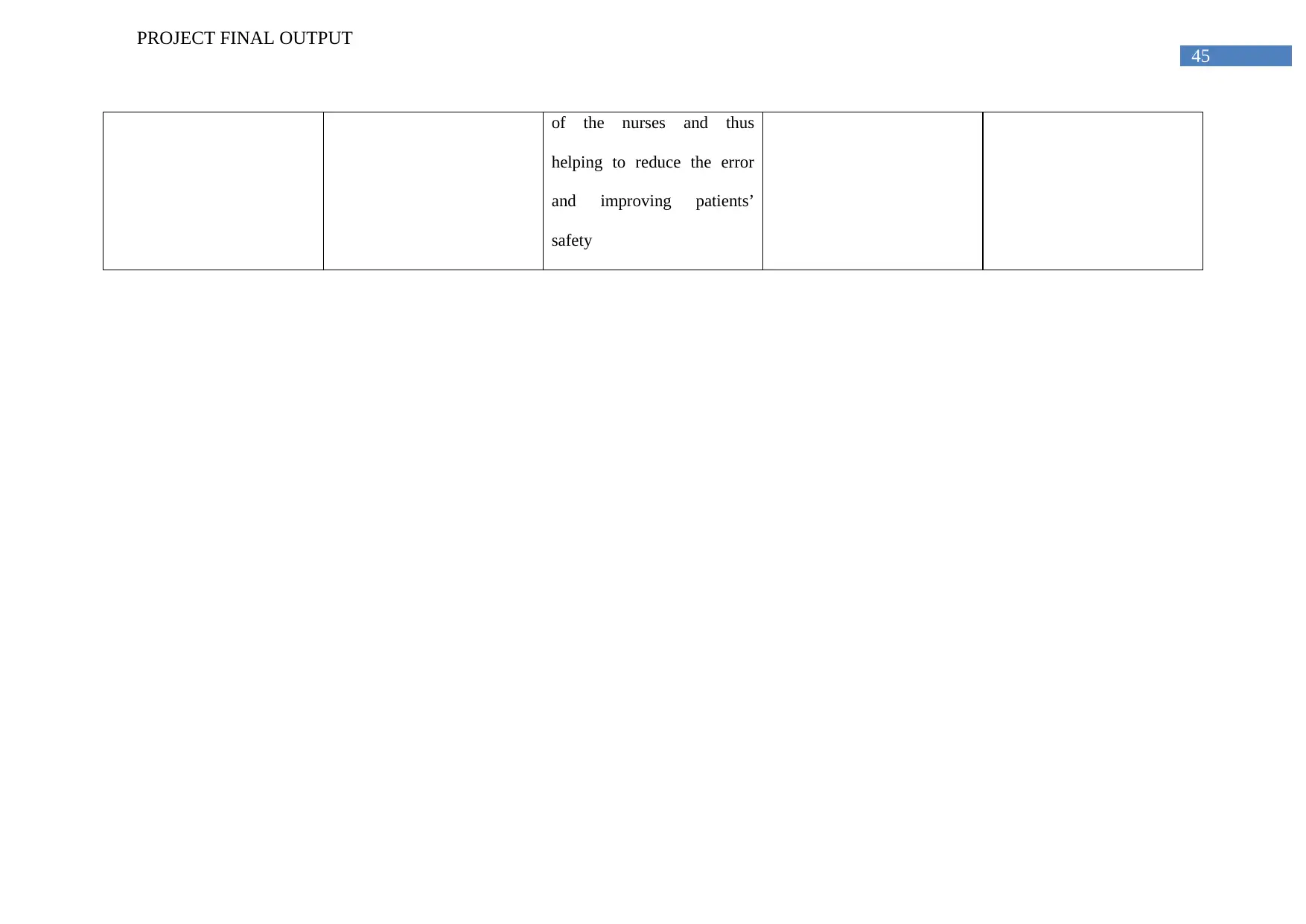
PROJECT FINAL OUTPUT
of the nurses and thus
helping to reduce the error
and improving patients’
safety
Related Documents
Your All-in-One AI-Powered Toolkit for Academic Success.
+13062052269
info@desklib.com
Available 24*7 on WhatsApp / Email
![[object Object]](/_next/static/media/star-bottom.7253800d.svg)
© 2024 | Zucol Services PVT LTD | All rights reserved.





